#the world exists on the yggdrasil tree
Text

ETRIAN ODYSSEY...............
#fire emblem#feh#LIKE. obvs world tree is a concpet. that exists. and feh takes a lot for real world mythology#so (guy who knows shit about fuck voice) both etrian and feh currently must be taking inspo w yggdrasill/life tree concept#I THINK. there was a life tree in awakening too but i don't remember anything about it save for the map#I'M JUST. I'M REALLY FASCINTED ACTUALLY. I HAVE A LOT OF THOUGHTS TAHT DON'T CONNECT AT ALL#BUT I'VE CONNECTED THEM.
19 notes
·
View notes
Text
One of my favorite things about Control is just how completely and utterly nuts/bonkers/GONE the FBC is as one of these ‘secret government blackops’ groups.
Like this is a trope we’re all fairly familiar with at this point; some secret government organization formed to monitor, contain and research all kinds of weird shit and keep it secret from the public. Also they may or may not have kinda gone totally rogue somewhere along the way and might now answer only to themselves at this point in a ‘who watches the watchers?’ commentary on the need for oversight.
But the more you find out about the Federal Bureau of Control, the more it becomes clear they just so utterly past ANY of that by the time the game begins. And have been for basically the last fifty some odd years.
Like here is a basic overview of the FBC that you learn within the first thirty or so minutes of the game: They are a secret government organization dedicated to the containment, cataloguing and research of supernatural artifacts and events. They are headquartered in what they call ‘The Oldest House’, a tall, imposing yet utterly nondescript building in the middle of New York City that is literally impossible for anyone to enter or even notice unless they already know about it. And the interior of the building is actually a twisting extradimensional labyrinth that also opens up to other dimensions/realities and might actually be the World Tree Yggdrasil. It also kind of hates any technology made in the last twenty years. And apparently Number 2 Pencils.
Oh, and the FBC doesn’t really report to the US Government. They report to a floating, inverted black pyramid that exists in a space outside of known reality that might also be the collective human subconscious. The pyramid is colloquially referred to as ‘The Board’ and they are an extradimensional entity/group of entities that appoints the Director of the FBC via the use of a physics-defying geometric gun called ‘The Service Weapon’ that is probably Excalibur/Mjolnir/every other legendary weapon in human myth. They also speak in word-salads and probably know they are in a video game.
See, back in 1964 when the FBC first discovered The Oldest House, they basically decided ‘WOW, this place is cool! Let’s make it our new headquarters!’ and promptly moved in. This was also when the current Director at the time found the Service Weapon within The Oldest House, made contact with/was chosen by The Board and from the point on the FBC really hasn’t answered to the US Government anymore.
Also, the Government basically doesn’t even know the Bureau even EXISTS anymore. Remember how The Oldest House has this kind of ‘Perception Filter’ that prevents almost anyone from entering it or even noticing it, which is how basically nobody can find it despite the fact that it is right in the middle of New York City? Well, after they moved in and became effective ‘residents’ of the house, this filter started applying to the FBC itself. They basically CAN’T be noticed or remembered at this point by anyone who isn’t part of the organization. The reason this secret organization can operate entirely off the grid and can’t be tracked is because they literally have freaky extradimensional reality-warping covering their tracks.
This is what I meant when I said that the FBC is just so far GONE. At this point, the FBC is itself a crazy, supernatural thing in and of itself.
Other fun details about the FBC include:
The Bureau facilities in The Oldest House are not powered by coal, oil or nuclear power. No, instead the lights are kept on by a former director who went a tad power-mad and lost control of his pyrokinesis, so the Bureau locked him up in a giant ‘Sarcophagus Containment’ unit and now use him as a power-generator. He also sometimes talks through the waste-disposal furnace to try and get people to bring him human sacrifices.
The maintenance sector of the FBC includes an area called the ‘Black Rock Quarry’. The so called ‘black rock’ is an extra-dimensional mineral that, among other things, blocks and dampens supernatural effects and abilities. Needless to say, the Bureau mines the stuff extensively. Now, despite being within The Oldest House, the Black Rock Quarry is an open-top quarry. To space.
One of the ways Bureau personnel get around is via pull-strings that show up all over The Oldest House. Pull a string three times and you are transported to the Oceanview Motel, a quaint little motel that probably exists outside of known reality because no one has ever been able to actually go or see outside the motel. Once you’re there, you just ring the bell on the front desk three times, do some random task and procure a room key. The key opens a door, but only one with an inverted black pyramid. From there, you pull another string and are transported back to somewhere else in The Oldest House. So basically a rather convoluted teleportation system. There are also doors with other symbols that probably go to other realities, but the Bureau hasn’t figured out how to open them. Though one does seem to lead to a void of malevolent darkness that feeds off human creativity and is currently holding one Alan Wake.
Also, the bureau’s janitor is probably a Finnish Sea God.
#control#control 2019#federal bureau of control#ahti the janitor#rambling about one of my favorite games
2K notes
·
View notes
Text
Kabbalah in the Worldbuilding of Genshin Impact; Part 1: The Tree of Life, the Universe, and Everything
Edited for clarity, 12/6/23
Written by Schwan (@abyssalschwan on twitter) and Sabre (trashcanlore, @paimoff on twitter)
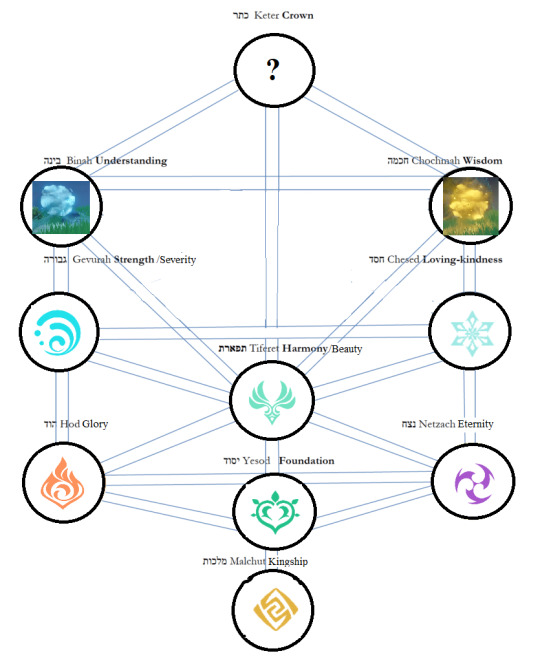
During the Sumeru Archon Quests, we learned that the Irminsul is a (real! (ish)) tree that grows upside down, seemingly underground, and that the roots of the tree are the Ley Lines, which extend throughout Teyvat and the Abyss. Irminsul stores all knowledge and memories in the world, and the Ley Lines are the mechanism by which the tree acquires this information. Ley Lines move elemental energy through Teyvat, and this energy acts as both a storage medium for information but also a resource that can be utilized for combat, alchemy, an energy source (Azosite), etc.
The origin of the name Irminsul (unique to the Western localizations) in combination with the many names from Norse mythology associated with Khaenri'ah, suggest that the inspiration for Irminsul is Yggdrasil, the world tree and central axis of the cosmos in Norse mythology. Here we propose an additional inspiration for Irminsul and the associated worldbuilding and elemental system of Teyvat: The Kabbalistic Tree of Life. In this model, Teyvat’s elemental energy is comparable to the creative energy described by Kabbalah as the foundation for the creation of reality and the spiritual world. Specific attributes of elemental energy can be channeled by unique individuals in Teyvat and these attributes manifest as distinct elements, which can be directly compared to the 10 sefirot, or emanations, described in Kabbalistic literature.
What is Kabbalah?
Kabbalah (lit. received, tradition) is a school of thought originating in Jewish mysticism. In general, Kabbalah focuses on the relationship between the infinite (God) and the finite universe and how it was created. The goal of studying this mysticism can vary depending on the school of thought and their motivations. Many of the esoteric and religious influences on Genshin lore and worldbuilding were influenced by Kabbalah, or vice versa. These include Gnosticism, Hermeticism, alchemy, Freemasonry, the occultist branches of Theosophy and Thelema (Golden Dawn), astrology, symbolic interpretation of the tarot (also specific to the Golden Dawn) and more [2]. In short, Kabbalah is everywhere. Additionally, its concepts are used as symbolism in several pieces of media that directly or indirectly inspired Genshin and other games in the Hoyoverse.
If you have frequented Genshin lore topics, you might have heard that one of the main sources of inspiration for its worldbuilding is Gnosticism. The problem is, Gnosticism is a bit vague or contradictory when it comes to how the world was created and how the whole existence thing works. At this current moment in the storyline of Genshin, we have very little information on the very beginning of existence in Teyvat. This information seems to be a crucial part of the “truth of the world” and appears to be purposefully hidden by powerful factions like Celestia. This entire theory was born out of trying to make sense of what little we know about the creation of Teyvat and comparing it to esoteric commentaries on the well known creation myth of the Torah (Old Testament). The “Biblical world structure” interpretation of Teyvat has been around since the early days of Genshin lore and with good reason; there are frequent mentions of the firmament, as well as the name Teyvat sounding very similar to the Biblical Hebrew word for ‘ark’ (although the grammar is a bit mangled). There are also several references to stories from the Bible in in-game texts, including Before Sun and Moon.
Kabbalah literature spends a lot of time trying to understand and describe the process of how the world was created and the underlying principles of reality, as well as how spiritual practice can change that reality (either metaphorically or literally). Kabbalah intends to describe the “true nature of God,” which is equal to the entirety of existence, as something very vast and completely impossible to grasp. This incomprehensible infinity emits an “limitless light” that is the origin of all creation. Elemental energy (the ubiquitous source of everything in Teyvat) is often found compared to light, something we’ll discuss in more detail later. The “limitless light” of Kabbalah is way too powerful for existence to bear, much like how elemental energy is to normal, non-Vision having humans. That’s why this light needed to be “filtered” down. This happens through the process of creation, which passes the light through the spiritual attributes that form the Tree of Life, which is like a sort of diagram for how the universe came into being [3].
The Tree of Life
The tree of life and its 10+ nodes, known as sefirot, is one of the most well-known concepts from Kabbalah to make its way into popular culture. As mentioned previously, the tree has been used as rule-of-cool symbolism in anime such as Neon Genesis Evangelion and Fullmetal Alchemist, two pieces of media that likely are significant influences on Genshin (If you doubt that HYV loves NGE, play some Honkai). The sefirot are also depicted on the floor of the Schicksal HQ map in Honkai Impact 3rd, for some reason.
The sefirot and their organization and interactions with each other can be found depicted in many ways, such as the tree format that is the most popular, or a spiraling nested scheme that is really cool, or even very stylized, like the work of Robert Fludd.

Sefirot
Sefirot comes from the root word in Hebrew meaning “to count,” but you can also find it translated as “sphere” in some texts. The term originated in a book on Jewish mysticism called the Sefer Yetzirah, or “Book of Formation/Creation.” which describes the combination of the “sefirot of nothingness” and the 22 letters of the Hebrew alphabet as the foundation of reality (remember the hypostasis codenames?).
The Sefer HaBahir (lit. the book of brightness, 13th century France) introduces the idea that the sefirot are emanations of the divine. Interestingly, this book refers to the sefirot as ma’amarot (sayings), which builds on an important concept in classical Jewish philosophy – the idea that God spoke the world into existence. [We’ll get back to the Sefer Yetzirah and the role of language in creating the world in a subsequent part of this theory]. Fontaine 4.2 era edit: HELL YEAH stay tuned for more about Oceanids!!
Historically, Kabbalah might have taken this rough concept from a very different school of thought: Pythagoreans or neo-Platonists. Briefly, the connection between the Pythagoreans and the Kabbalistic sefirot is that both groups considered the world as being made of numbers. This ties back into Genshin worldbuilding because of how much Platonism is related to Gnosticism. Something else to keep in mind is that Pythagoreans (who had a cool history that connected Egypt and Greece to the magic of ✨math✨ but also hey Genshin lore hello Deshret) were known to use lyres as their instrument of choice while making mathematical studies of music. More sus Venti lore for the collection? This is also interesting to consider in the context of Nahida, who is deeply connected to the Irminsul, and has animations that are reminiscent of computers.
Later in the 13th century, the Kabbalist Isaac the Blind would 'canonize' the list of sefirot (there’s still some variation to this day) and organize them into a sequence that would become the basis for the famous Tree of Life structure. His writings described the sefirot as attributes of the divine and their role in the creation of the world. In his model, the sefirot originated from lights that emerged from a primordial soup of potential, and these sefirot/lights would then ‘flow’ and emanate into each other. His student, Azriel of Gerona, expanded on this with a neo-Platonic lens and introduced the concept of the Ein Sof, the infinite nothingness that cannot be comprehended and is the origin of everything. In this model, being flows from an infinite resource of potential, which the divine can utilize through the framework of the sefirot, eventually creating the world [4]. In simple terms, the Ein Sof, which contains everything, emits a primordial light that then differentiates into the sefirot. In our Genshin analogy, this primordial light would be like extremely pure elemental energy that differentiates into elements, like light passing through a prism.
Moses Cordovero, an important figure in the development of Kabbalah, described the process of the sefirot differentiating with the analogy of light shining through a stained glass window:
Imagine a ray of sunlight shining through a stained-glass window of ten different colors. The sunlight possesses no color at all but appears to change hue as it passes through the window. The light has not essentially changed though it seems so to the viewer. Just so with the sephirot. The light that clothes itself in the vessels of the sephirot is the essence, like the ray of sunlight. That essence does not change color at all, neither judgment nor compassion, neither right nor left. Yet by emanating through the sephirot -- the variegated stained glass -- judgment or compassion prevails. (Pardes Rimmonim by Moses Cordovero, translated in Essential Kabbalah by Daniel Matt)
Cordovero considered the sefirot to be completely independent of each other, but the later Lurianic school of Kabbalah (we’ll get into them more in later parts) considered the sefirot to be constantly dynamically interacting with each other and also assigned them personas.
Achievement grinders amongst us may recall the descriptions of the namecards you get upon completing the Elemental Specialist achievement series:
Achievement: Colors of the Rainbow: Light can refract into countless colors, but people stop at seven because they're too lazy to count. Perhaps the elements are like that, too.
Achievement: Seven Lights: Anyone can play a tune that belongs just to them, and like the dew under grass, can reflect the seven lights of heaven.
Another example of the elements being compared to light is the Latin text found on the magic circles on the door of Mona’s future house in Mondstadt and generated by the hypostases during their missile attacks. The text reads:
Ex culmine lucis in magno elementorum, which translates to "From the peak of light, to greatness of the elements."
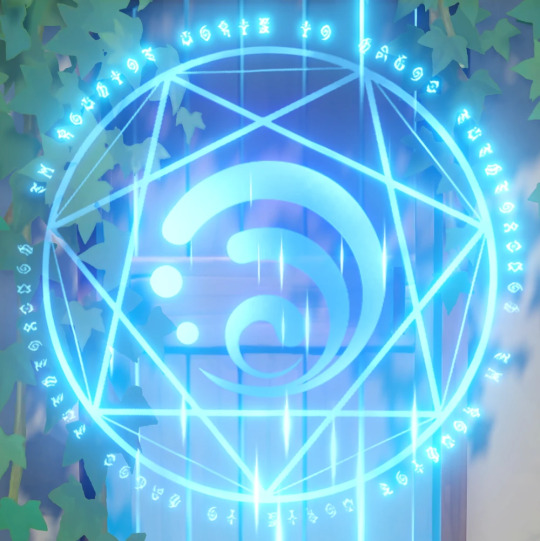
It’s interesting to see this text appearing in association with the hypostases since they are described as “life forms which have completely abandoned their former appearance and biological structure, making them able to reach the highest level of elemental purity. They are ultra-compact structures with a high mass, and are the highest forms of elemental structures.” The hypostasis code names are also all Hebrew letters, as mentioned earlier.
Mona’s astrolabe during the Unreconciled Stars event features a similar text:
Ex culmine locis in magno elementorum; Lux se effundat in mentes dei, which translates to "From the peak of light, to the greatness of the elements; May light pour out, into the minds of god."
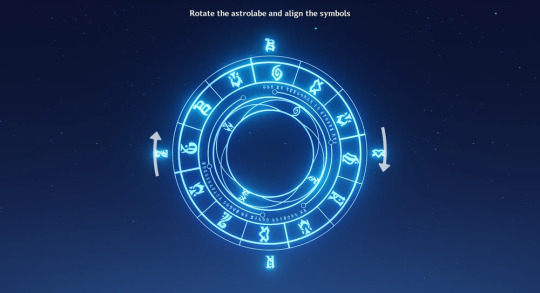
The Abyss Lector catalysts contain a text that mirrors these two examples:
Ex culmine lucis in mango obscuritas. Lux se effundat in mentes abysso, or “From the peak of light, to the greatness of darkness. May light pour out into the minds of the abyss.”
The Genshin elements are also described as flowing. For example, a loading screen tip specifically describes the Ley Lines as “A mysterious network that links the whole world together, within which flow the elements.” The Silver Twig description states: "All knowledge, memory, and experience flow through this giant tree, just like a stream flows into a river, the river joins a sea, the sea turns into clouds, and the clouds rain onto the ground — just like life itself."
Sefirot and the Genshin Elemental System
The 10 (sometimes 11) sefirot are:
Keter: Crown (this one is even more symbolic that the rest, is described as “the most hidden of all hidden things" in the Zohar, represent things that are above the mind’s comprehension and the very beginning of the process of turning potential into reality)
Chokhmah: Wisdom
Binah: Understanding/Reasoning
(Da’at: Knowledge, as a fusion of Chokhmah and Binah)
Chesed: Loving Kindness or Mercy
Gevurah: Strength/Severity, (sometimes Din, Judgement, or Pachad, Fear)
Tiferet: Beauty/Harmony, is associated with balance of the Tree of Life
Netzach: Eternity/Endurance
Hod: Splendor/Glory
Yesod: Foundation (as in, foundation of reality)
Malkhut: Kingdom/Sovereignty
You’ve probably noticed by now that while we are claiming that the concept of the sefirot applies to the elemental system in Genshin, there are 10 sefirot and only 7 elements (for now). Fortunately for us, the Kabbalists love metaphors and categories. In addition to the sefirot representing the procedure used to ‘emanate’ and create the world, there are other methods of interpretation that further subdivide and rank the sefirot. For example, one metaphorical interpretation of the Tree of Life assigns each of the sefirot to a part of the human body.
In some Kabbalistic traditions of interpreting the tree, the 10 sefirot are divided into two categories: Intellect (Keter, Binah, Chokhmah) and Emotions (they’re actually more like character traits), which contains the remaining seven. These categories are meant to parallel how the soul is also divided into the intellect and emotional components. The first three sefirot are also referred to as the “three mothers,” because they are the source of the lower seven [5].
Having a group of seven sefirot is very convenient for comparing their traits to the elements and their ideals, but what about the role of the higher three in Genshin worldbuilding? This next section requires a bit more conjecture than some other comparisons here.
The source of all elemental energy in Teyvat, whatever that actually is, could be compared to Keter (crown), the most hidden and incomprehensible of the sefirot. (Big stretch, but think of the crowns over the Irminsul trees in domains.)
Next, we have the Ley Lines, which contain dreams and memories (these are basically the same in Teyvat, see Dream Solvent description), and these can be compared to Binah (understanding/reasoning) and Chokhmah (wisdom). During the Sumeru Archon Quest, Rukkhadevata says that dreams are the source of the wisdom she upheld as her ideal. Memories play an important role in discerning the truth of the world, as the traveler has now found themselves to be the only person to remember certain people/events, and has been told to trust their memories rather than what they can see.
Comparison of the 'Lower' Sefirot to the Genshin Elements and Their Ideals
Chesed (loving-kindness); Cryo (unknown, theorized to be love)
The Cryo Archon’s ideal is theorized to be love, as it’s the only characteristic mentioned in relation to her in the Travail trailer. Wanderer’s voiceline about her directly mentions love and describes her as being kind and benevolent, while Childe describes her as extremely gentle. These are the characteristics of Chesed, which represents the trait of completely selfless love: the all forgiving, all giving love of a god towards their creations. When it comes to the Cryo element itself, two things are worth mentioning: one is the way that all of Snezhnaya is perpetually covered in snow, as if this were the (ironic) physical expression of the Tsaritsa’s love blanketing them. The second is the promise of a world-encompassing snowstorm that will envelop everything as the Fatui advance on their war against Celestia. Although it’s hard to find one absolute constant in Vision granting stories, it’s notable that most Cryo users got their Vision at a moment when they had to selflessly be there for others (Diona, Chongyun, Mika), or after a decisive moment where they put aside their personal comfort for an ideal that would result in benefit for others (Kaeya, Eula, Layla).
Gevurah (Severity); Hydro (Justice)
Gevurah is associated with divine judgment, the kind that punishes humanity and causes world-altering catastrophes like the flood or the expulsion of Adam and Eve from the Garden of Eden. The Hydro Archon organizing her nation around a Court that attempts to judge both deities and humans parallels this. In a more positive sense, Gevurah is also related to moral judgment that allows one to tell good from evil. Likewise, Hydro in-game is often associated with purity and separation of clean and unclean matter. When it comes to Hydro Vision wielders, one common characteristic is that they all live by a personal ethical code, and their commitment to it is what granted them their Vision.
Tiferet (Beauty/Harmony); Anemo (Freedom)
Tiferet balances the other sefirot on the tree and has direct connections to almost all of them (except for Malkut). Similarly, Anemo can facilitate many elemental reactions via its Swirl reaction. In our opinion, something almost all the Anemo characters share is that their moment of receiving a Vision coincides with a moment of balance and harmony with themselves or their environment. See Jean and Kazuha’s Vision stories and the cutscene where Scaramouche/Wanderer gets his Vision. As an aside, comparing harmony to Anemo is funny because Venti is a bard and harmony is also a musical term: in music theory, harmony is the way we analyze the interactions between different voices that can be heard at the same time.
Netzach (Eternity); Electro (Eternity)
The quality of “Eternity” in Netzach is related to victory against enemies, referring to eternity as being the most powerful combatant remaining among defeated adversaries. Likewise, in Genshin the story of the Electro Archon features many battles during the Archon War where Ei and Makoto ended up victorious. As for Electro users tend to have their Vision granted at a moment when their ambition “defeated” the obstacles of reality, as was the case with Fischl, Kuki and Lisa. Cyno’s Vision story makes sense when you compare it to the illumination of Buddha during meditation, and how this was victory over the temptation of the demon Mara.
Hod (Glory); Pyro (War)
Natlan and its Pyro Archon are possibly the most mysterious of all the regions, so we can only speculate. We know that the Pyro Archon is called the God of War, and that the Pyro Gemstone mentions battles, pilgrimages and truth. The sefira of Hod, translated as Glory or Splendor, is linked to being able to connect with God and therefore also associated with prophecy (as in the way a human can carry a message from God). In the Travail trailer, the Pyro Archon tells the traveler that “the rules of war are woven in the womb.” It's also theorized Natlan will be based on Mexica culture (where sacrifice of both enemies and self sacrifice was a way to connect with the gods) and via Iansan's name, the Caribbean diaspora version of Yoruba religion (where many rites involve the gods making themselves present in the material world).
Yesod (Foundation); Dendro (Wisdom)
Back when we started to think about this theory during version 2.8, we decided on Yesod largely via process of elimination. One piece of our rationale was that in the Jewish tradition, each of the lower seven sefirot are used to represent a primary personality trait of seven archetypal figures in the Torah. The person related to Yesod is Joseph, who is well known for his prophetic dreams, and because of the events of the Golden Apple Archipelago, we decided that was close enough. However, the 3.x version confirmed that a) Irminsul did actually exist, b) Dendro as an element has a deep relationship with the tree, with the Dendro Archon acting as its avatar, c) the ideal of wisdom as both Dendro Archons interpreted it has a lot to do with dreams, and d) Irminsul and the Ley Lines act as the foundation for how reality is perceived in Teyvat. Yesod is also associated with biological life, as it represents the reproductive organs in the human body scheme of the sefirot.
Malkut (Kingship); Geo (Contracts)
Malkut is associated with the connection between the spiritual "above" of the Tree of Life and the concepts it contains, and the "below" of the material world, where these concepts manifest into material reality. For this reason, Malkut is associated with the earth [6]. In many Geo item descriptions, like the Geo Hypostasis drop or Albedo's elemental skill, the motif of geo trying to reach the sky is a constant. From a religious POV, the relationship between the divine and humans living in the material world has also been one of "covenants," or "pacts", in a similar way to how the Geo Archon is the God of Contracts. Furthermore, contracts are the basis to have a working state (government), and a kingdom is one of the first forms of a state. Malkut also being related to earth and everything material parallels how Geo is an element that works in making constructs. Geo Vision users are likewise involved in making or maintaining structures, like the Knights of Favonius is for Noelle, or the tradition of alchemy is to Albedo, as well as opera to Yunjin and in a way, even the Oni identity for Itto.
The Origin of Evil and Why Irminsul is Upside Down
Tighnari tells us that Irminsul is a tree that “grows downward rather than upwards,” or in other words, it’s upside down. This isn’t the only time that we’ve encountered things in Teyvat being described as upside-down or mirrored, and as it turns out, there is a similar scenario described in Kabbalah. Throughout Kabbalistic discussions on the origin of evil in the world (both material and spiritual), a central idea developed is the existence of a mirrored or inverse Tree of Life that forms the demonic realm of evil. The Zohar, a foundational work of Kabbalistic literature, spends a considerable time discussing the origins of evil - there are more than 5 creation myths for the concept of evil! Two of these myths describe the formation of an inverse Tree of Life, called the Sitra Achra (literally “other side”). This tree is constructed out of corrupted fragments of divinity that did not make it through the creation process, and therefore became evil forces [7]. Evil is typically represented as either a shard (like of broken pottery) or as a husk/shell (Qlippoth in Hebrew). Sound familiar? We actually have an enemy with this name in-game; the "shadowy husks" (the CN name for these enemies literally translates to "empty shell").
Unlike the very well defined 10 sefirot of the Tree of Life, Kabbalists don't agree about the identities or number of the demons that form the Sitra Achra. Some names for these demons are consistent; such as Lilith, Samael, and Asmodeus, who make a sort of "mother, father, son" trio. As for the rest, scholars generally agree that Kabbalists blended traditions from nearby cultures depending on where they lived, leading to Arabic, Spanish and Germanic legends mixing into the Jewish tradition [8]. There's a strong possibility Hoyoverse did something similar and filled in the missing names with the names of the demons of the Ars Goetia, creating a system where the mirrored sefirot are “ruled” by demon gods, aka, the Archons. This implies that the reason Teyvat is upside down is because it is actually on the “other side.”
Neuvillette, About Us: Witness: Since you hail from beyond the stars, I invite you to be my witness as I judge this upended world…”Though we live in a world of disarray, I shall undertake to restore all that has been broken”.
[Fun Fact: The Zohar describes the construction of the Sitra Achra as a series of knots that arrange the demonic equivalent of sefirot, called either crowns or “breaths,” into a mirrored Tree of Life configuration [7]. ]
The primary goal of the Sitra Achra is to steal and absorb the divine energy of the Tree of Life to maintain its existence, in the hopes of gaining enough energy to destabilize the system [9]. The way Genshin's Archons use their Gnoses is similar to this system. In the Flower of Paradise Lost artifact lore, the Goddess of Flowers explains to Deshret and Rukkhadevata that when the Seelie race was disgraced, they lost their connection to Heaven and their power of "enlightenment". Later, Celestia would facilitate the Archon War with the promise that each winning god would be granted a Gnosis that would give them exceptional power. Both Nahida and Venti have described the Gnoses as being a very advanced tool that concentrates elemental energy. So far, Archons have had inherent elemental powers related to their nature, but when it comes to using large amounts of elemental energy through their Gnoses, they aren't creators but channelers of it, just at a much larger scale than humans who have Visions. Edit: and yes, there is the most recent revelation about the origin of the Gnoses that is extremely relevant to this comparison, but deserves its own space to be properly expanded on.
However, this doesn't mean Teyvat is condemned. Just as the Traveler has slowly been setting the chaos of elemental energy back into order (by, for example, returning the elemental Oculi to the Statue of the Seven, among many other things), so too is there a concept in Kabbalah describing the importance of righting the wrongs of the universe so that the sefirot are stable and creation is in harmony with the divine. This is called Tikkun Olam, or the repairing of the world.
Stay tuned for part 2 where we go into wayyyyy more detail about what this means for the Traveler's journey through Teyvat! 4.2 Edit: and of course will we will be talking about the most recent Gnosis revelation, as well as the Narzissenkreuz Ordo antics :D
References:
https://www.chabad.org/library/article_cdo/aid/170308/jewish/What-is-Kabbalah.htm
https://en.wikipedia.org/wiki/Hermetic_Qabalah
Kabbalah - Origins of the Sefirot and Tree of Life - Isaac the Blind Saggi Nehor & Azriel of Gerona
Mystical Concepts in Chassidism - Schochct, Jacob Immanuel, chapter 2
Mystical Concepts in Chassidism - Schochct, Jacob Immanuel pg 66-67, Tanya ch. 3
Rebbe Nachman of Breslov, Likutey Moharan I, 12:1 via Wikipedia
The Origins of the Klippot / Qliphoth & Sitra Achra in the Zohar - Kabbalah on the Problem of Evil
https://www.jewishvirtuallibrary.org/demons-and-demonology
9. Evil in Early Kabbalah - Emanations of the Left Hand Side - Origins of the Qliphoth / Klippot
#genshin#genshin impact#genshin lore#please tell me you get the joke in the title XD#the kids do not know about 42
395 notes
·
View notes
Text
Aaah! It's an A!

Let's forget about the Z in Legends: Z-A for a moment. What is this, ay? It's tall, green, pointy, and the bottom of it looks like veins on a plant.
My guess? It's the Pokemon version of Yggdrasil, or to be more general, the Tree of Life archetype. In many myths this is the original tree, the origin of life, and the "A" at the beginning of the alphabet.
Pokemon recently represented the similarly archetypal World Turtle with Terapagos, and the interesting thing is that some cultures have a World Turtle AND a Tree of Life. Take a look at the Tree of Life page - it's interesting.
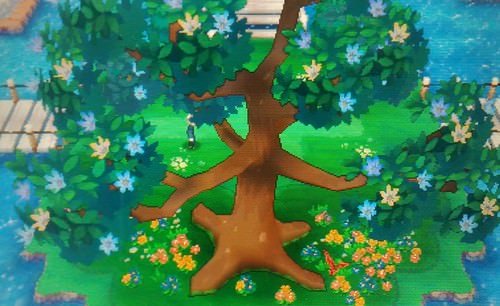
Screenshot From: Reddit
To illustrate this point, there is a tree at the Cave of Origin in Sootopolis that grew from seeds that AZ brought to Hoenn. Everyone rightfully talks about the Eternal Floette flower underneath the tree, but nobody talks about the tree itself, planted at the Cave of Origin. Like some kind of origin tree.
X and Y are most known for its Norse inspiration since Xerneas, Yveltal, and all three of Zygarde are based on creatures that live in Yggdrasil. But interestingly, OmegaRuby and AlphaSapphire return to the Hebrew symbolism of Gen 3, building upon it with themes of beginning and end. Groudon, Kyogre, and Rayquaza take some inspiration from the Biblical "chaos monsters" Behemoth and Leviathan the making the Omega and Alpha symbolism pretty fair.
So if there are Tree of Life myths that this hypothetical Pokemon takes from, I'm guessing it will take from Norse and Hebrew myth as well, both Yggdrasil and the Tree of Knowledge. In fact, according to Bulbapedia AZ and the Eternal Flower may be based on the legend of the Wandering Jew, or "Eternal Jew". It probably is, since the Wandering Jew plants (now known as inch plants or spiderwort) look like this:
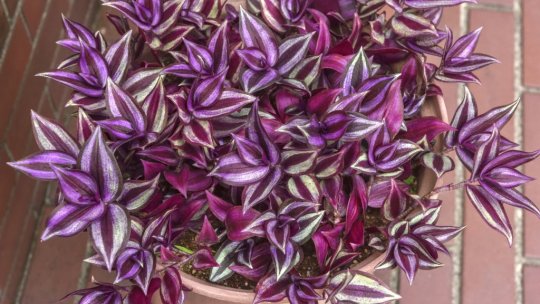
Source: Gardening Know How
I'd also like to point out that Omega and Alpha are just the Greek version of Z and A, end to beginning As in, OmegaRuby and AlphaSapphire already did the Z-A motif. This kind of synergy makes me hopeful that Legends Z-A will expand on the cultural and mythical themes of Gen 6.
Okay, but the tree at the Cave of Origin looks nothing like an A, aye? Well, the "tree" part of it doesn't, but that's just the symbol mean to suggest the Tree of Life.
And I think the actual Tree of Life Pokemon is
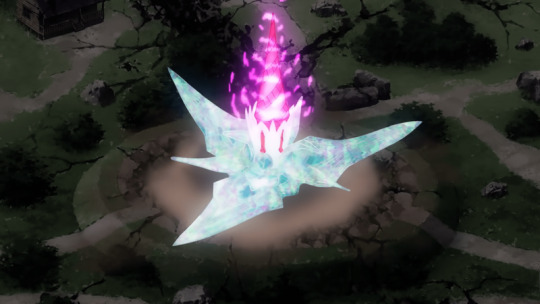
Source: Bulbapedia
Think about it: what is an "Eternal Flower"? Floette's flower isn't a part of it, so for AZ's Floette to have an Eternal Flower, one has to exist in the first place as a living, organic flower, which suggests that the Ultimate Weapon is alive in some way. And the Eternal Flower planted at the Cave of Origin can't be the one AZ's Floette holds, because it's actually planted there.
Many Tree of Life myths involve searches for immortality. That's why the archetype is called the "Tree of Life". AZ originally built the machine to grant immortality. That's probably where AZ gets his name: the "universal remedy" of alchemy, Azoth, closely related to the Philosopher's Stone. It was only afterward that AZ altered the machine to make it into a weapon.

Source: Bulbapedia
I'm definitely not the first person to say that the "A" looks like the Ultimate Weapon. Either the machine was built on top of the Tree of Life Pokemon, or it was built from single giant Eternal Flower that blossomed from the Tree of Life Pokemon.
Every letter in Gen 6 designates a Pokemon, so I'd be very surprised if "A" does not designate a Pokemon too. Wait...
Edit:

*bangs head against table* How did I not catch that?! Sometimes it's even used as the "middle" letter of the Greek Alphabet between Alpha and Omega!
What is the title of this game, a secret message or something? Z crossing into lambda making A? "End making middle into beginning..."?
#I had more but this was too long already#Pokemon Legends Z-A#Pokemon Legends Zygarde#Pokemon#Pokemon Legends Z#Pokemon Legends#Zygarde#Pokemon Legends ZA#Gen 6#Kalos#Pokemon Legends z a#Pokemon games#gaming#Pokemon XY#Pokemon Z#Pokemon XYZ#Gen 6 Pokemon#Video games#AZ#Lysandre
60 notes
·
View notes
Text

Yggdrasil:The Sacred World Tree
Talon Abraxas
Yggdrasil: Unveiling Mysteries of The Sacred World Tree
Yggdrasil, also known as the Tree of Life, stands at the center of the Norse cosmos, serving as a conduit between the nine realms. Its immense branches extend across the heavens, and its roots delve deep into the great realms, tapping into legendary wells and streams for sustenance. This colossal ash tree serves as a cosmic axis, linking together the realms of gods, humans, giants, and various other beings.
Roots of Yggdrasil
Yggdrasil's roots draw power and sustenance from three different sources. The first root reaches up towards heavens and into Asgard, the realm of the gods, and taps into the well of Urd. Shielded by the root’s magic, by the well stands a beautiful hall that is home to three maidens – Urd, Verdandi, and Skuld – who shape the lives of men and are known as norns.
The second root extends to Jotunheim, the domain of the giants. Here, the root taps into the Mimir’s well, whose waters are coveted by many for containing boundless wisdom and which is guarded by its eternal guardian Mimir. Here, at Mimir’s well, Odin sacrificed his eye for a drink from the well to obtain supreme wisdom and solidify himself as the leader of the Aesir.
The third and final root travels to Niflheim, the icy realm of the dead. This root taps into the wellspring of Hvergelmir, a massive cauldron from which all rivers originate, symbolizing the primordial source of life and creation. This wellspring is a home to many snakes and serpents, with the great dragon Nidhoggr living among them.
Within the vast expanse of Yggdrasil, there exist nine interconnected realms. In addition to Asgard, Midgard, and Niflheim, the World Tree also links to realms such as Vanaheim (abode of the Vanir gods), Alfheim (dwelling of the light elves), Jotunheim (the land of giants), Svartalfheim (the domain of the dwarves), Muspelheim (the realm of fire) and Helheim (abode of the dead). Each realm has its own unique characteristics, inhabitants, and significance within Norse mythology.
Among the Branches of Yggdrasil
Asgard: Home of the Aesir Gods
Asgard, situated atop Yggdrasil's highest branches, is the realm inhabited by the Aesir gods. Ruled by the mighty Odin, Asgard is a place of divine splendor, where grand halls and palaces stand in golden brilliance. It is from Asgard that the gods oversee the mortal realm, engage in epic battles, and prepare for the final battle of Ragnarok.
Midgard: The Realm of Humans
Midgard, often referred to as Earth, is the realm of humankind. Suspended within Yggdrasil's middle branches, it is a world populated by mortals, their settlements, and their adventures. Midgard is constantly influenced by the gods and their actions, shaping the fate of both individuals and civilizations.
Jotunheim: The Land of Giants
Jotunheim, nestled within the roots of Yggdrasil, is a realm inhabited by the jotnar, or giants. These formidable beings range from mountainous brutes to cunning and deceptive creatures. Jotunheim serves as a land of challenges and conflicts, frequently intersecting with the affairs of gods and heroes.
Vanaheim: Abode of the Vanir Gods
Vanaheim is the realm of the Vanir gods, a pantheon associated with fertility, prosperity, and nature. Located within Yggdrasil's branches, Vanaheim is depicted as a lush and fertile land, where bountiful harvests and vibrant ecosystems flourish under the Vanir's watchful eye.
Alfheim: Dwelling of the Light Elves
Alfheim, situated above Midgard, is a realm inhabited by the ethereal and luminous light elves. Known for their beauty and connection to nature, the light elves possess great wisdom and magical abilities. Alfheim is often associated with light, joy, and enchantment.
Svartalfheim: Domain of the Dwarves
Svartalfheim, residing within the depths of Yggdrasil, is the realm of the industrious and skilled dwarves. Known for their craftsmanship and mining expertise, the dwarves forge powerful weapons, legendary artifacts, and intricate treasures. Svartalfheim is a realm of hidden caverns and wondrous craftsmanship.
Niflheim: The Frozen Underworld
Niflheim lies beneath the lowest roots of Yggdrasil, a cold and mist-shrouded realm associated with ice, frost, and darkness. It is home to Hel, the ruler of the dead, and the souls of evil men who passed into this ice realm after traversing Helheim.
Muspelheim: Realm of Fire
Opposite Niflheim, Muspelheim exists as a realm of searing flames and intense heat. Ruled by the fire giant Surtr, Muspelheim embodies the primal power of fire and is foretold to be instrumental in the apocalyptic event of Ragnarok.
Helheim: Abode of the Dead
Helheim is a realm of the dead, located beneath the roots of Yggdrasil. It is a somber and desolate place ruled by the goddess Hel, where souls who did not attain glory in battle or gain entrance to other afterlife realms reside. It represents the acceptance of mortality and the finality of death in Norse mythology.
Inhabitants of Yggdrasil
Yggdrasil is not only a physical entity but is also inhabited by various mythical creatures. Beneath its roots resides Nidhoggr, a colossal dragon who gnaws at the roots of the tree, representing decay and destruction. The eagle perched on Yggdrasil's highest branches looks down on Nidhoggr below, embodying knowledge and inaction. The squirrel Ratatoskr scurries up and down the tree, acting like a messenger between Nidhoggr and the unnamed eagle, fanning the flames of hate between them by spreading nasty rumors and ferrying insults that one has for another. These inhabitants further contribute to the vivid and complex tapestry of Norse mythology.
Symbolism of the World Tree
Yggdrasil is a profound symbol in Norse mythology, representing the interconnectedness of all things in the cosmos. It embodies the cyclical nature of life, death, and rebirth, underscoring the idea of continuous renewal and regeneration. As a world tree, it also symbolizes the axis mundi, a universal concept found in many mythologies, where the physical and spiritual realms meet.
The image of the tree resonates deeply with human existence, reflecting the innate human desire to seek meaning and connectivity. It reminds us of the intricate web of relationships that bind us to the natural world and the forces beyond our comprehension.
Yggdrasil, the World Tree of Norse mythology, is a powerful symbol that encapsulates the cosmos and its profound interconnections. It serves as a gateway to the realms of gods, giants, and the dead, and its roots tap into the wellsprings of cosmic wisdom and primal creation. As we delve into the mysteries of Norse mythology, we unravel the layers of symbolism embedded in this awe-inspiring ancient tree, reminding us of our place in the grand tapestry of existence.
So, let us gaze upon Yggdrasil, this towering arboreal monument that stands as a testament to the enduring power and enduring fascination of Norse mythology. May its endless branches forever inspire us to explore the depths of our own roots and seek wisdom in sacrifice.
49 notes
·
View notes
Text
A Glorious Culmination
Let's talk about that perfect ending with its beautiful scenes and epic soundtrack, shall we? Here's all the reasons why I loved it:
The ending answered the question "what makes a Loki, Loki?"
"Authority, independence, style". Sure, but that's not all of it. And it's not the real answer.
So who is Loki? A villain? A loser? What defines Loki?
There are many characteristics that define Loki but one of the main ones that truly sets him apart imo is that he is a catalyst for change. Loki when faced with options he doesn't like, or a problem that looks like doesn't have a solution, makes a new way, creates a new solution, chooses an option that didn't exist before.
He has the power to destroy, like the mythological tale of Ragnarok.

And to give life. Like how the Ragnarok he brings, means the beginning of a new cycle in Norse mythology.

-"Yeah it was the best character development. Loki went from wanting a throne to..."
Let me stop you there.

Loki went from not wanting a throne but thinking he must have it to be considered worthy and an equal to Thor, to taking a throne despite not wanting it, because it was the right thing to do.
The fact that Loki sacrificed himself once again for the people he loved and cared about, wasn't a new character development. In the movies Loki risks and sacrifices himself every time when it matters. For Thor, for Asgard, for the world. The only development here was that this time he sacrificed himself for every universe there is.
And his sacrifice wasn't treated as sth he deserved by the narrative because of every terrible things he'd done. On the contrary the narrative acknowledges that this is the last thing Loki deserves. That he is paying for others' mistakes and wrongs. He spends centuries to save the timelines. He spends a long time trying to stop Sylvie without harming her. And when everything seems lost, he makes a decision to save everyone but himself, he creates a different path. He faces his deepest fear, to not hurt the people he loves.
If there is any character development, it's for the narrative and the audience that finally recognized who Loki actually is.
The Symbolism
I have to say my first reaction to the new Loki costume was:" This is the worst Loki costume ever :))))" also me two days later: "I'm gonna set it as my wallpaper." But I loved the symbolism. The biggest horns Loki's ever worn to show the weight of the crown. His cape that was connected to timelines, to show the burden of a throne. The simplicity in his clothes in contrast with his other outfits. Because this wasn't about the recognition Loki always wanted and deserved. This was about the responsibility Loki decided to literally put on his shoulders and feeling the gravity of it.
His shoes though :)))) I mean

Either let him be bare footed or give him boots you cowards :D
The Parallels
The fact that how the ending parallels the first Thor movie and everything came back full circle.
How Thor and Loki destroyed sth at the cost of themselves losing the people they cared about.


Loki doing sth not because of a desperation for acceptance, not because he thought it was sth someone else wanted.
Knowing if he chose the easier way, no one could have fault him for it because it seemed there was no other way.
He did it because he knew it was the right thing to do, because he knew who he wanted to be.


Loki not giving up, not letting go, not falling down from a broken bridge, but ascending, holding on as he fixes what's broken.
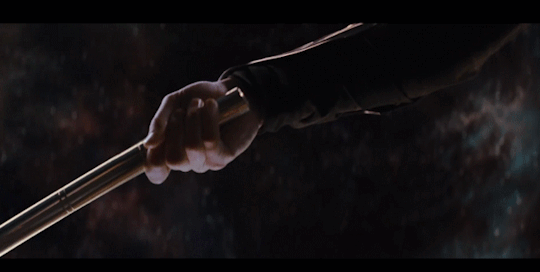

He holds and carries the whole universe on his back. It's not only a beautiful Atlassian tragedy, but also parallels Norse mythology in more than one way. Yggdrasil, the tree of life in Norse mythology, the one that Loki holds in his hands in the finale, wasn't the only parallel in the ending.
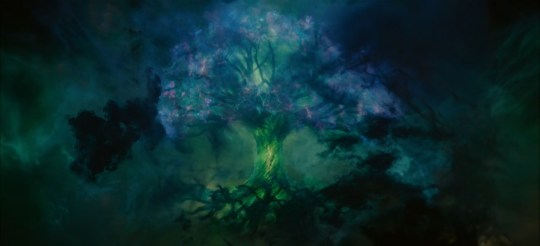
There's a subtle and beautiful nod to Norse mythology. The tale of Loki being bound till Ragnarok. The myth that says when Loki gets freed, the end of the world begins.
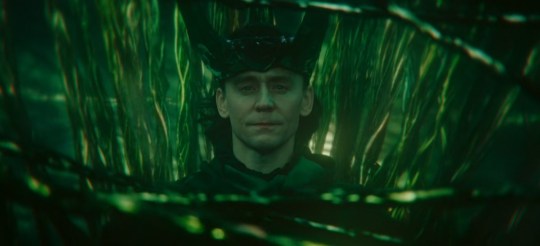
What a marvelous tragedy. And what a glorious culmination.
It's not all tragic though
Loki now is literally the most powerful and heroic character in MCU. He's holding the universe in his hands and keeping it alive. You can't top that.
And it makes his portrayal in the recent movies in which he was unfairly underpowered, even more ridiculous than before and that makes me happy :D
There is also a possibility to see Loki again and I'm not talking about the other variants. Marvel now has the best dues ex machina through Loki. He might be able to appear in any universe as an illusion to warn about dangers or help the characters. He might figure out a way to keep the tree alive without being there himself. That way he can find Thor in the sacred timeline. Or maybe the Loki who survived Thanos and is still in the sacred timeline finds Thor. Maybe there's still hope for a good reconciliation and a good story for Asgardian siblings.
So to sump up this was an epic, symbolic, beautiful and tragic ending. And yet hopeful. I loved it💚
#anyone else was reminded of Elsa when Loki created those stairs? :D#loki never wanted a throne#had to include it because everyone's going with this take and it starts to get on my nerves#just look through the tag if you disagree with me#a lot of people has written metas about it#loki 2x06#loki s02e06#loki#loki series#loki tv show#loki s2 positivity#loki gif#thor#thor1#norse mythology#yggdrasil
123 notes
·
View notes
Text
You know the Norse 9 realms perhaps. Yggdrasil, the world tree. But the idea of a world tree, cosmic tree, exists in many cultures/mythos. But what of the Vedic 14 realms? The Lokas.
Let's discuss.
As said, there are 14 worlds/realms 7 higher ones 7 lower ones.

Following?
7+7=14
We're not using Terrance Howard math here.
Okay. These are the Vedic lokas (because there is a more commonly accepted number in Hinduism - nuance moment: commonly accepted, doesn't mean it's believed in totality by everyone).
K, back to the 14 first.
The higher 7 lokas are said to be the heavens, inhabited by the gods and celestial beings more affiliated/closer to "truth" - in vedic and hindu terms, this is idea of divine truth, waking up to the realizations of the universe - maya (the grand illusion), think more awakened, fully formed, wise, have achieved some form of spiritual liberation from ego and the like). And to counter - the 7 lower are often thought of as "hells" - not exactly fire and brimstone but where you suffer the consequences of bad karma, having to live out/purify yourself.
In some iterations, yes, hellish beings to use that phrase, and demons (of a like) can occupy those lower lokas.
As mentioned earlier, in Hinduism, one of the most common take on the lokas is the: Trailokya.
Or three lokas, three spheres, planes of existence, three worlds, often considered: Earth (Bhuloka), Heaven (Svarga), Hell (Naraka), or - Earth (Bhuloka), Heaven (Svarga), and the Netherworld (Patala).
This is just a primer - because of the birth of Buddhism and it's spread, the idea of lokas spread as well to cultures that later adopted Buddhism. So there is a Tibetan Buddhist take on lokas, a Chinese Buddhist one, Vietnamese, and there is even a Jainism interpretation/belief on lokas.
#Nordic realms#yggdrasil#vedic gods#vedic chart#vedic#Lokas#hinduism#hindu mythology#celestial realm#Bhuloka#Earth#Heaven#Hell#Netherworld#Svarga#Naraka#buddhism#tibetan buddhism#chinese buddhism#Vietnamese buddihsm#Jainism#world tree#world myths#belief system#world religions
24 notes
·
View notes
Text
*inhales, holds it, then exhales* Okay, so.
Yesterday, I realized that hey, I could ~stream~ Loki Season 2, and boy did I gorge myself on that while working on art for an event. Now, I will be among the first to say that Marvel's Loki is not The Loki, but man. That climax. You should have seen my face as Loki brought all the threads of time together and sculpted them into a tree.

Yggdrasil
*inhales again* God, that is some good shit.
I'm not gonna lie, that entire final episode just. For the first time, it felt like someone at Disney/Marvel read the myths and understood them. Marvel's Loki may not be The Loki, but as a variant, as a representation of that myth, he finally hits home.
Loki is known as the god of mischief, chaos, and trickery, but he is so, so much more than that. He's the god of Consequences, of Fuck Around and Find Out. He is the god who knows his own fate. If Victor Timely is He Who Remains, then Loki is He Who Endures. He who endures loss, grief, anger, pain and agony.
Loki is He Who Endures the destruction of self, again and again and again. First when he is bound in the roots of Yggdrasil, poison dripping into his face for countless years, then again at Ragnarok, when he sails with the giants, knowing he will meet his death at Heimdall's hands.
Unlike the Aesir, Loki never runs from his fate. He never tries to avert Ragnarok. He knows that it must come, and that he must be the sacrificial lamb to slaughter. In the hope of building something new, something better than before. In the hope that this time, they'll get it right.
There are a lot of different interpretations of Ragnarok out there. Some say it's a singular event that has already happened, others say it is yet to come. Personally speaking, I like the idea of Ragnarok being cyclical, of being a metaphor for failure and self-improvement.
Loki Season 2 Episode 6: Glorious Purpose is a time loop. One where Loki goes through numerous centuries worth of repetitions trying to find a way to prevent the Temporal Loom's destruction - in other words, Ragnarok. Yes, in this retelling of the Ragnarok myth, Loki does try to evade his fate, but the important factor is that he doesn't give up. He never declares it hopeless, and he watches his friends, his sister-self, everyone in the world not just die, but cease to exist, over and over and over again.
Until finally he realizes that he cannot avert Ragnarok. That the Temporal Loom must be destroyed. There is no way around it.
But that destruction doesn't have to mean the end of everything.
"I know what kind of god I want to be."
And in that moment, he becomes the sacrificial lamb, willingly walking into his own imprisonment because this is the way it must be. Because he must give everything, he must destroy himself, and he must endure the pain of loss, of grief, of isolation.
For love. For hope. For a chance to build something better.
For all time.
Always.
#loki#mcu loki#loki season 2#personal unverified gnosis#i'm having so many feelings about both Lokis don't mind me
21 notes
·
View notes
Text
fantasy geography lesson anyone?
Nah, not really, but:
I've referenced a place called 'Sun's Heart' a few times talking about Daybreak without actually fully explaining what it is, so here's that.
The short answer: it's the birthplace of the Relics, death place of the Gods and the final resting place of Irene.
The Long answer:
Ru'aun is literally the centre of the world. Every map, Ru'aun is in the middle, as it's simply the most accurate. Tu'la is to the west, Gal'ruk north-east, and a third region/continent to the south-east called An'lar. In the dead centre of Ru'aun is a vast and beautiful forest that takes up mush of the continent.
Many centuries before the first human settlers came, the Gods created the magi of Ru'aun, and the rest of the world, but they put the majority of their magical beings on their homeland. Ru'aun is the birthplace of the Primordial Gods, seven omnipotent, omniscient beings responsible for creating all life in the realm. Other Gods existed in other realms, but the seven main guys were all in what is most commonly called "the overworld" but is formally named Gaius.
In the very centre of Ru'aun was a giant, enchanted tree created of seven saplings planted at the Gods' births, having grown and twisted around themselves into one massive tree of multicoloured branches and leaves, sheltering a thriving community of faeries and elves, fuelling the Magick of the forest and fae that resided within it, keeping the whole place safe and alive.
Hyria was one of these faeries, though she lost her wings in the Fall of Sun's Heart- a cataclysmic event that ended Sun's Heart as a city. It happened suddenly, without much warning. Great swathes of wildlife, reduced to black ashes and ichor. The first invasion of The Void, killing off massive stretches of land across the continent.
The Gods did everything they could to try and fight it off, but their efforts yielded too little too late, and The Void threatened to wipe out their world. Their creations were driven to cower in Sun's Heart, beneath the shelter of their enchanted trees, where The Void couldn't reach despite trying.
The Gods came to a devastating decision- one that would save their world, but likely destroy Sun's Heart in the process. They could channel their own powers through the tree, into its roots, which spread throughout the entire continent, and although this would kill them and their home, it would save Ru'aun, and the rest of Gaius from this horrid corruption.
And so, they did just that. All of their Magick, their Divine powers flooded Ru'aun, wiping out The Void and restoring the lush, beautiful forest they created in the very beginning. When the burning light faded, seven saplings remained planted in the earth, a gaping hole in the ground covered in a miles-deep web of tangled roots of the great tree, and seven sparks of fire floating above the now black branches of the saplings.
Sun's Heart, the city, was destroyed, the people were wounded, some irreversibly so, but the Gods' sacrifice had worked. Emerging from the forest, the magi discovered that the land had been healed by their Magick.
For a time, everything was normal again.
Then the forest came back. The Sacred Forest came tearing through the earth- roots tore up roads and trees burst up overnight through homes. The foliage overgrew and tangled the bodies of those who couldn't run fast enough into its thorns.
This was the Fall of Sun's Heart, as the Sacred Forest reclaimed its land, and the seven Divine Relics were swallowed by the saplings, suddenly growing up over them and twisting back into its original tree. Sun's Heart was destroyed, left in ruins, and almost impossible to find.
The Elves found a new home, creating the enchanted Yggdrasil grove, creating a symbiotic relationship with the forest. Most of the Faerie population was wiped out, claimed by the forest in their stubborn attempts to stay in Sun's Heart.
Sun's Heart remained empty until Hyria led the Divine Warriors to it, seeking the power to fight off The Void once more. Hyria knew of the Gods' sacrifice, how their power was channelled into Relics that the elves and fae gave names over the years between the Sacrifice and Fall of Sun's Heart.
Hyria showed the Warriors to the ruins of her old home, and was struck by the beauty of it- dappled beams of sunlight between the dancing shadows cast by the canopy, babbling brooks running between cobblestones covered by layers of spongy green moss. Ferns swaying in a soft breeze, the sounds of birdsong echoing through the branches and sweet smells of wildflowers filling the air.
The trees had worn away from the power that emanated from the Divine Relics, hollows in the trunks that glowed with the light of them, growing brighter as the soon-to-be-Divine Warriors stepped closer. Each Relic seemed to claim a person on its own, two Relics drawn to Irene herself.
Hyria elected to stay in Sun's Heart, so her Divine friends would know where to find her, should the need arise. She tidied up her old home on the edge of the old city, moving in alongside the small creatures that had come to call it home. She had no quarrel with the Sacred Forest, not anymore.
She came to learn that Esmund created the Golden Roads through the forest a few years after the Divine War between the Warriors and The Empty, a series of roads carved through the forest without disturbing the nature too much, then blessed with runes and carvings to prevent anyone following them from getting lost.
Wandering off of the roads will lead you to one of two places: Yggdrasil, the hidden home of Ru'aun's high elves, like Zoey, which requires specific directions to be followed.
Or Sun's Heart, where most people who get lost in the Sacred Forest wind up. Sun's Heart has a weird... curse? Enchantment? Hyria didn't put it there, nor does she know what it is, she just knows how to avoid it, but walking in a straight line in any direction off of the Golden Roads will eventually lead you directly into Sun's Heart, where you're either killed by the creatures living there, or dragged into the bottomless pit hidden between the twisted trunks of the Gods' tree. The World Tree, I should probably call it.
Anyway, yeah. That's what Sun's Heart is.
I guess this is kind of a geography lesson, isn't it.
12 notes
·
View notes
Text

An infographic of the Nine Realms for those that love Norse mythology. It is an abstract representation that is designed to show the realms in a way that closely resembles the descriptions of the Eddas. Each shows some features and inhabitants that make the realm distinct, and it shows how the realms connect to each other and Yggdrasill. In reality, all realms would be nested within each each other and fit somewhere on our planet (either in a physical location or in an invisible spiritual location).
Heavenly Realms (upper level):
_____________________________
* Ásgarð - Home of the Æsir. Each God rules over a kingdom and has his own palace within Ásgarð. Óðinn rules the realm from his high throne. The Einherjar make the palace of Valhall their home. 1/2 of the greatest slain warriors are chosen by the Valkyries to join Óðinn's army and await their final battle against the invading armies of Giants at Ragnarok.
(In this image you can see Óðinn standing at the entrance of Valhall, monitoring the training of his warriors)
* Vanaheim - Home of the Vanir. Once enemies of the Æsir, but now their tribes have been unified. Freyja rules over this realm and other half of the Einherjar join Freyja in Fólkvangr where they train until Ragnarok.
(In this image you can see Freyha and one of her cats leading her warriors in drills)
* Álfheim - Home of the Álfar (Elves). Noble nature spirits that are allies of the Æsir Gods. Elves have dominion over nature and inhabit sacred hills, streams, or groves where they keep the land healthy and prosperous with their magic.
* Gimlé - In Ásgarð nearbye Álfheim exist other minor heavenly kingdoms, like Viðbláinn. Here a palace sits high in the mountains called Gimlé, where the souls of the righteous go after death. It is also where the last surviving Gods will seek shelter from the fires of Surtr in the final days of Ragnarok.
* Bifröst - The Rainbow Bridge. This brightly colored bridge provides a path for the Gods to quickly travel from Ásgarð to Miðgarð. It burns with magical flames that will incinerate any Frost-Giant or Hill-Giant that attempts to invade the home of the Gods. But the Sons of Múspell are immue to the flames, since they are Fire-Giants, and will collapse the bridge as they charge over it to destroy Ásgarð during Ragnarok.
_____________________________
Yggdrasill:
_____________________________
* Yggdrasill - The World Tree. This mighty Ash has roots that run far and wide, connecting all the realms. Yggdrasill also houses a pair of humans that will emerge and repopulate the world after Ragnarok. Long ago, Óðinn hanged himself from this tree to learn the secrets of the magical runes
* Urðarbrunnr, Mimisbrunnr, & Hvergelmir-
Yggdrasill stands next to the Urðarbrunnr (well of Urð. Urð is the eldest sister of the 3 Norns, Giantesses that weave the strands fate into an intricate tapestry, which reveals the destiny of all living things. The waters of this well have healing properties and the 3 sisters anoint the roots of Yggdrasill daily to stave off decay.
(In this image the 3 Norns can be found standing beside the Urðarbrunnr)
One of Yggdrasill's primary roots travels into Jotunheim, where it drinks from the Minisbrunnr (Mimir's Well). This is the well where Óðinn sacrificed his eye in order to gain his great wisdom by drinking from the well.
The final primary root of Yggdrasill runs into Niflheim, to the Hvergelmir. This well of boiling water is home to numerous serpents and the terrible wyrm, Niðhoggr. These beasts gnaw upon the root, slowly killing it with their venom.
* Hraesvelgr, Ratatoskr, Niðhöggr, Veðrfölnir, & Eikthyrnir - These creatures live in or near Yggdrasill and interact with each other and the world's -
Hraesvelgr sits high in the top-most branches, flapping his broad wings to create the winds. Veðrfölnir is a hawk that sits between the eagle's eyes and he may act as an informant for the eagle, like Huginn & Muninn.
Niðhöggr periodically travels to the opposite shore of the Hvergelmir, near Helheim. This shore is known as Náströnd (the Corpse Shore) and while there the wyrm drinks the blood of the newly arrived damned souls (oath-breaketlrs, adulterers, and murderers).
Ratatoskr is a squirrel that runs up and down the roots of Yggdrasill, so he can relay hateful messages between Hraesvelgr and Niðhöggr.
Eikthyrnir is a stag that feeds upon the leaves of Yggdrasill above Valhall. Dew gathers on his antlers and drips down to the Hvergelmir where it becomes the source of many rivers. In some accounts there are 4 stags, but this may be a later alteration to the story.
_____________________________
Mortal Realms (middle level):
_____________________________
* Miðgarð - The realm of men. The Gods frequently travel to Miðgarð to entertain themselves, influence humanity, or slay invading Giants. Thór, the Bane of Giants, is the protector of Miðgarð.
(In this image you can find Thór, the protector of Miðgarð, has just made his way across the Bifröst)
* Niðavellir - Home of the Dvergar (Dwarfs). These magical beings are nature spirits, related to the Elves, but not divine like their cousins. They shelter under the earth where they are safe from the deadly sunlight and craft marvelous magical weapons and tools for Kings and Gods. Sindri, the most famous of Dwarfs lives in this land.
* Svartálfheim - Home of the Svartálfar (Dark Elves). These Elves are craftsmen like the Dwarfs and are frequently identified as Dwarfs due to their similar appearance and lifestyle. The most well-attested Dark Elves in the Eddas are the smith brothers, onown as the Sons of Ivaldi.
* Miðgarð Sea - This vast body of water surrounds Miðgarð to protect the world from the vicious Giants on the other side. Jörmungandr, the World Serpent, makes this his home after being tossed into the water by Óðinn. Over the centuries he has grown so large that he now encircles the entire world. Beneath the waves lay Rán's Hall, the Goddess of the sea makes ready her home for the poor souls that drown at sea.
* Jötunheim - Home of the Hill-Giants. The Kingdoms of Útgarð (King Útgarða-Loki) and Thrymheim (Skaði) are found here. In the Eddas we hear how Thór and Loki have travelled to Jotunheim many times seeking adventure or revenge.
_____________________________
Primordial Realms (lower level):
_____________________________
* Ginnungagap - In the beginning there was a vast yawning void, a featureless plain standing in the darkness, and absent of life. From this land emerged 2 realms: Múspellheim to the south and Niflheim to the north.
* Múspellheim - This volcanic realm is home to the primordial Fire-Giant, Surtr. His army, the Sons of Múspell, is the most powerful and destructive army in the world. Surtr patiently waits for the day he is destined to lead the invasion of Ásgarð. After the world was created, the Gods and Dwarfs gathered sparks and embers from Múspellheim and used them to craft the Sun, Moon, and stars, so that the sky would be illuminated and men could track the seasons.
* Niflheim - This frozen realm is the home of the dead. All humans that are not granted access to one of the other realms to live out their afterlife are destined to reside here. Hel was banished to Niflheim, where she rules over these damned souls. But she was not the first ruler of this realm. In the beginning, the enormous Frost-Giant called Ymir became the first living being to inhabit the world. He would father the tribes known as the Frost-Giants and Hill-Giants, but he was slain by Óðinn, Vili, and Vé. These 3 brothers re-purposed his massive corpse, fashioning it into Miðgarð.
Source: Aaron Chapman (2023)
From: Everthing Norse & Vikings Culture [Facebook]
#Aaron Chapman#Yggdrasil#yggdrasil#Yggdrasil art#yggdrasil art#Yggdrasil World Tree#norse mythology#norse myths#world tree art#everthing norse & vikings culture#norse mythology art#norse pagan#norse paganism#Travelling the World Tree#Nine Realms#nine realms art
20 notes
·
View notes
Text
Been wanting to scream about this for a while now, figured now is a good as ever time to do so.
So Gundam: Witch From Mercury really leans heavily into the whole witches and witchcraft theme, which is interesting for a sci-fi show. Not to say that they don't do it gloriously tho and in this post I will be pointing towards some of the symbolism that I noticed in the show.
The series starts with the first witch we see inside a Gundam Mobile Suit, none other then our dearest Elnora Samaya, also now known as Prospera Mercury. During the prologue, before anything else, we see her and once she exists the dark of the cockpit its revealed that she has fiery, blood red hair.
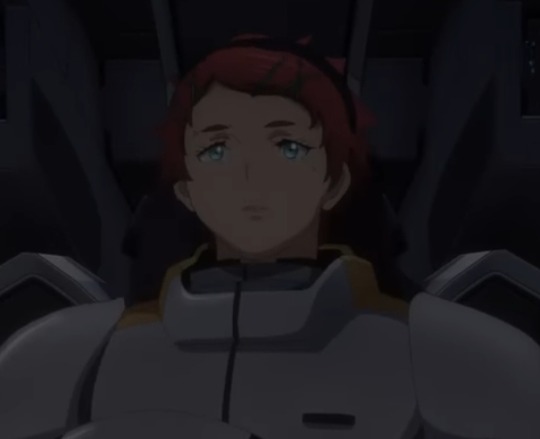
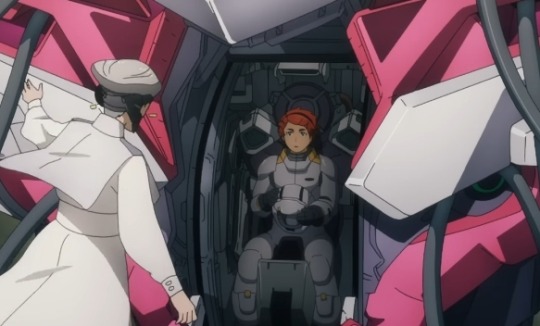
(Source: prologue G-witch)
Historically, witchcraft has been associated with red heads because of the many prejeduces against them. Red heads are a minority who have been associated with a lot interesting figure, from Judas who betrayed Jesus to the depictions of Lilith. This has given redheads a negative connotations in the Western World.
Next we see that the head researcher leading this project on GUND-format is also a woman, an older woman at that. Dr Cardo Nabo is the visionary leading this project, dedicated to the cause of making the GUND-format work in conjunction with humanity, in order to improve their lives and perserve their future. She knows that humanity, if it wishes to expand further into space and continuenits next steps into exploration and living outside of Earth, will need technology in order to aid their bodies in order to survive and thrive.
Older women involved in a form of medicine is an other motif in witchcraft and witch stereotypes. Witches were often involved in medicine and care. Cardo is the italian way of refering to a thistle, a purple green prickly flower that was said tp have medicinal properties in the middle ages.
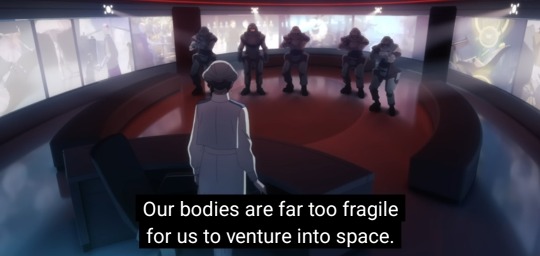

(Source: Prologue G-witch)
During this prologue and later in the show it is revealed that the reason why the Vanadis Institute, of which Dr. Nabo was the head of, was doing resesrch into the GUND-format in conjunction with Mobile Suits because that was the primary way to get access to money for further research. Military funding through Ochs-Earth, an Earthian military company, would allow the Institute to further their goals and to show the viability of the GUND-format.
However, they encountered difficulties during their research. Mobile Suits are far larger and more difficult to control then prostethic limbs. The higher the permet score used by an individual to control more of the suit, the more the chance of death grows. Anything higher then score 3 caused deaths to the user because of, presumably, a data overload caused by the Permet link.
This caused a lot of ethical debates and strife, presumably, where the GUND-format was cast into a dangerous and even inhuman light because of its potential to not just kill others but also the users themselves. This led to the eventual forceful suspension of the project by the council, during which Cathedra used the Dominicus Forces to attack and kill all those present on Fólkvangr, the asteroid where the Vanadis Institute was located. Those present on Fólkvangr were both staff of the institute as well as their family. Everyone who was involved or related to the development of the GUND-format were killed in what is essentially a witch hunt.
Fólkvangr is an other reference to witchcraft, as in Norse Mythology this is a heavenly field in the afterlife ruled over by Freyja, a goddess of many things including magic (to see and influence the future). An other name for Freyja is Vanadís. Once again, this is a reference to paganism and witchcraft within the G-Witch universe thats quite obvious. Ochs also may or may not be a reference to the Old English word for "Oak" (not too sure about that one), if this is indeed true then this may be a reference to Thor, god of Thunder and Lightening as well as a warrior. I considered connecting oaks to Yggdrasil, the world tree, but that is an Ash tree, not an oak.
During the discussion in which the Mobile Suit council werebdeciding the fate of further development of Gundam Mobile Suits, Delling came forth and said that they had to "Wield the hammer of witches" in order to put a stop to the development of Gundams. The "hammer of the witches" is a reference to the Malleus Maleficarum, a 15th century guide on hunting and persecuting witches.
During his speech at the conference, he also calls the fact that gundams kill not only other soldiers but also their wielders a curse, once again a reference to witches. Prior to saying this he also says however that humans should kill humans, instead of humans being killed by just technology (really simplifying this) but essentially what he is saying is that the Gundams killing their wielders is unnatural and goes against the normal way of things.

(Source: Prologue G-witch)
The irony of this is also the name of these organisations. Cathedra is a literal reference to the throne upon which a bishop sits, Dominicus means "of the Lord/Lord's". Both are a reference towards christianity and its opposition to both withcraft and paganism.
Now we have established whom exactly this show calls "Witches", these are the people involved in the manufacturing, research, development and piloting of the GUND-format and Mobile Suits using said format, be it for medicinal or war uses. If you are associated or sympathize with the use of this technology, you are considered "a witch".
Putting this into context, we can now also look at the name "Witch From Mercury". Who does this refer to? I've seen people argue that this might be Aerial or Prospera, but I sincerely disagree. As of the knowledge we have come to learn of in both the short novel as well as everything from episode 16/season 2 episode 4 onwards, we can assume that Suletta was the only one actually raised on Mercury and who feels any connection to the planet at all. Suletta, as both a pilot of a Mobile Suit using the GUND-format as well as the daughter of a witch (Elnora/Prospera), is a witch.
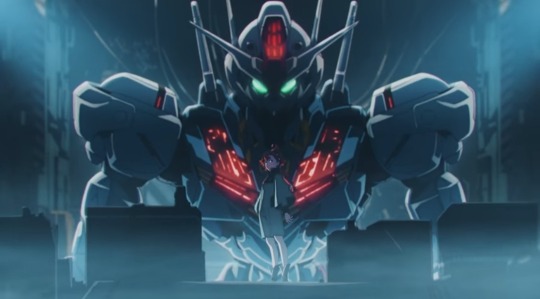
(Source: G-witch teaser announcement)
Now onto my FAVOURITE part: the 2nd ED Red Birthmark. Oh boi this baby has some of the more blatant witch references, I absolutely love it ngl. Starting with the name itself, historically one of the methods to hunt for witches was to check for birthmarks/skin marks. Having strange birthmarkings or an insensitive patch of skin was basically proof enough of you being a witch, again a part of the witch hunt theme.
The song, which I am convinced is from Miorine's perspective (tho maybe/perhaps Aerial, tho thats a small maybe), makes references to seeing into the future, not liking whats in it and changing destiny yourself. Once again, these are themes of clairvoyance, the sort of magic Freyja is associated with (aka Vanadís). Witches were often said to be able to look into the future and change things as well.
Next we have the visual parts if the ED. I'm sure we all ate utterly in love with.
youtube
From 0:44 to 1:00 we have this beautiful sequence of Suletta dancing and conducting GUN-bits.
First Suletta creates a stylized version of the Triple Goddess Symbol, a well known pagan icon amongst both witchcraft practitioners as well as wiccans. The symbol contains 3 moons in different phases; waxing, full and waning. The symbol represents the 3 phases of the goddess; the maiden, the mother and the crone. This is both the life lifecycle of a girl as well as the eay that wisdom is often bestowed upon a person, from the elderly to the adults to the children. You could even argue that this could represent Dr. Nabo, Elnora/Prospera and Suletta.


(Source: G-witch 2nd ED)
Following this we have 5 Suletta's dancing together in which one can assume is a circle dance. Circle dances bave historically been associated with both witches, pagans and cultists. Something ritualistic.
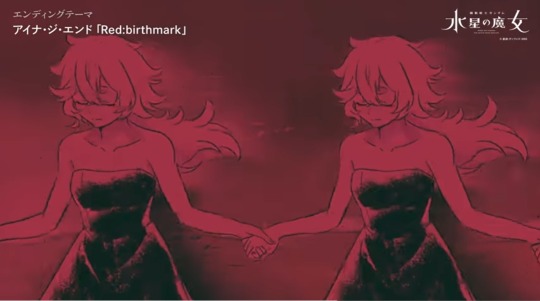
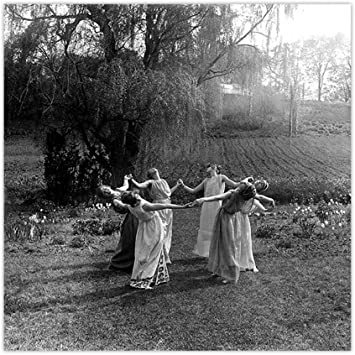
Anyway I'm tired now but there are like way more witchcraft references in the whole show that I can't get into right now cause I'm tired lmao. Anyway have fun with the above, peace.
#Youtube#g witch#gundam: the witch from mercury#suletta mercury#cardo nabo#lady prospera#prospera mercury#elnora samaya#witchcraft#paganism#norse mythology#witch hunt#anime analysis#red heads
110 notes
·
View notes
Text
RUNES HISTORY AND FACTS
There are many types of rune systems, including Younger Futhark, Anglo-Frisian Futhorc, Medieval runes, and Elder Futhark, which are the ones I’ll be talking about.
The Younger Futhark (long twig) has 16 runes and is typically used in translation with Old Norse. It was used in Scandinavia during the Viking Age, from 800 A.D to 1200 A.D.
Then you have Anglo-Frisian (Frisian being Dutch), which had around 30 runes and was used in Britain. It’s also known as Anglo-Frisian Futhorc.
The latest and closest to us is the Medieval Runes, which fall back into a 24 system (like Elder Futhark) with the Roman/Latin alphabet, which is also used in translation to Old Norse.
Finally, the Rune system we’re talking about is the Elder Futhark used in a 24-rune system and is used to translate proto-European languages (proto-Germanic, high Italic, proto-English, etc, NOT Old Norse!) None of the names of the Elder Futhark have truly been written down; they have come from reconstruction and guesswork from scholars. The names have come from Old English/Gothic sources and the Rune poems that feature names and pieces associated with names.
Norse=Runa English=Rune both meaning “a secret” or “mystery”
Old Norse=Rún Old Irish=Rún Middle Welsh=Rhin “to whisper” “secret” or “mystery”
Scots=Roun “To whisper” or “speak often about one thing”. It’s also associated with the Rowan tree in Scots, which is a very well-known magical tree in many folklores (also known as the “rune tree” or “the whisper tree”).
It was believed the Elder Futhark came from the Rome/Latin alphabet and had ancient Greek relations—due to the closeness of the Germanic tribes there and the mingling of Elder Futhark and High Italic.
The runes were not traditionally used as magical symbols. they were used in divination but were not considered magical themselves until later centuries, far after the Viking Age when they became popular as magical symbols. The furthest back they were found to be used was theorized to be Germania, as typically (but not always) female diviners would “cast lots” which were believed to later influence the Norse people to cast the runes. It was widespread for Norse kings, warlords, and explorers of this time to have a rune caster or diviner with them wherever they traveled. Diviners and Rune Casters at this time were well respected and always welcomed into people's homes.
Then in the myths, we find where Odin discovers the runes and shares them with the other gods. Later the gods share them with humanity. The god Odin stabbed himself with his spear, Gungnir, and hung himself from Yggdrasil for 9 days and nights without food or water sacrificing himself for the runes till they appeared to him in the Well Of Urd. This myth differs depending on the source you found it on. Then in the Havamal 80’ page, 31 of Jackson Crawford's translation of the Poetic Edda (elder edda), it states, “What you ask the runes will prove true; they are gifts of the Aesir, made by the gods and painted by Odin. You’ll learn best with your mouth shut.”
Freyr’s Aett
Fehu Uruz Thurisaz Ansuz Raidho Kenuz Gebo Wunjo
Hagal’s Aett
Halagaz Nauthiz Isa Jera Eihwaz Perthro Algiz Sowulo
Tyr’s Aett
Tiwaz Berkana Ehwaz Mannaz Lagaz Ingwaz Dagaz Othala
24 runes in total for the Elder Futhark
Freyr’s Aett
Everything for your basic human existence, talking with the divine, human social life, and the earth and its bounty, and how to live our lives happily or at least contently.
Hagal’s Aett
shows us how to navigate the difficult parts of life when things take a rough turn and you don’t know what to do. This Aett shows us how to move forward in life and cause change and unexpected luck for ourselves.
Tyr’s Aett
This Aett shows us how to connect with life around us like. We learn to connect with and communicate with Humanity, deities, and nature around us, as well as how to connect our physical worlds to the unseen spiritual worlds we work in.
Getting into the runes themselves and the meanings and associations
Fehu
Letter-F
God/Goddess-Freyja, Freyr
Meaning-Wealth or cattle
Association-Wealth, Livestock/cattle, prosperity, abundance, fulfillment, stability, success, new beginnings, things earned and won, reward, good health, unexpected good luck
Runic poems- Old English, “Wealth provides comfort, but you must share it who hopes to cast lots for judgment before the gods.”
Norwegian, “Money causes strife among kin; the wolf grows up in the woods.” Icelandic, “Money causes strife among kin, and the fire of the flood tide and the path of the serpent.”
Uruz
Letter-U
god/goddess-Ullr, Audhumla (the creation cow), Thor
Meaning-Ox or bull sometimes bison
Association- challenges, endurance, courage, strength, untamed potential, good health, good luck, moving forward after being stuck in stagnation, sudden breakthroughs, overcoming challenges, trials, power, creative forces
Rune poems- Old Norse, “The wild ox has great high horns with which it gores; a fierce fighter who boldly stamps the moors.”
Norwegian, “Slag is cast from bad iron; reindeer cross the hard snow.”
Icelandic, “Drizzle is the weeping of clouds, and blights the harvest and is hated by the herdsmen.”
Thurisaz
Letter-Th
god/goddess-Thor
Meaning-Giant or Thorn
Association-Strength, breaking down barriers, Thor's hammer, defense, reaction, temptations, resisting temptations, disruption, passion, protection, conflict, power
Rune poems- Old Norse, “Thorn is wickedly sharp and causes pain to those who grasp it, hurt to you who rest among them.”
Norwegian, “Giant causes the sickness of women; bad luck pleases nobody.”
Icelandic, “Giant is the torment of women, and the dweller of rocky vales and husband of Varthrun the giantess.”
Ansuz
Letter-A
God/goddess-The aesir, Odin
Meaning-Aesir, the ancestor god
Association-communication with the gods, wisdom, divine power, knowledge, creativity, understanding, passing tests, understanding, communication
Rune Poems- Old Norse, “Mouth is the source of the word, bringing wisdom and counsel to the wise, hope, inspiration, and a blessing to all.”
Norwegian, “Rivermouth opens most journeys; but the sword belongs in it’s sheath.” Icelandic, “Odin is the ancient creator, and Asgards king and lord of Valhalla.”
Raidho
Letter-R
God/goddess-Sol
Meaning-Wagon or chariot
Association-Rythme, journey, travel, personal development, change, evolution, decisions, taking the opportunity, movement
Rune poems- Old Norse, “Riding is easy for heroes inside a hall; it’s much harder astride a strong horse pounding against the great mile.”
Norwegian, “Riding is said to be the worst for horses; reginn forged the best sword.”
Icelandic, “Riding is a sweet sitting and a swift journey and the toil of the horse.”
Kenaz
Letter-K and C
God/goddess-Loki
Meaning- the torch
Association-Knowledge, Light, warm, illumination, visions, enlightenment, intuition, learning, Improvement, creativity, Inner voices, Breakthroughs
Rune poems-Old Norse, “The torch we know by its flame, which brings illumination, and light wherever noble souls encourage.”
Norwegian, “Ulcer is the curse of children; grief turns us pale.”
Icelandic, “Ulcer is the bane of children and a grievous blight and the house of rotting flesh."
Gebo
Letter-G
God/goddess-Odin
Meaning-gift
Association-Love, partnership, giving and receiving gifts, generosity, sacrifice, balance, joy in relationships, talents, abilities
Rune Poem-Old English, “A gift returns to adorn the giver with greatness and honor; it helps and heartens those who have nothing.”
Wunjo
Letter-W
god/goddess-Baldr
Meaning-Joy
Association-happiness, light, perfection, comfort, harmony, recognition of worth, reward, success, good health, prosperity, flourishing, bliss
Rune poem-Old English, “Joy comes to you who know no sorrow, blessed with grain and plenty, content in a strong community.”
Halagaz
Letter-H
God/Goddess-Hel
Meaning-Hail
Association-interference, disruption, corrections, changes for long-term good, change, being tested, nature, overcoming obstacles, wrath, chaos, misfortune, transformation
Rune poem-Old English, “Hail, whitest of grains, whirls down from heaven, is tossed by the wind, and turns water.”
Norwegian, “Hail is the coldest of grains; All-Father shaped the world in ancient times.”
Icelandic, “Hail is cold grain and a shower of sleet, and the bane of snakes.”
Nauthiz
Letter-N
gods/goddess-Skuld
Meaning-Need
Association-resistance, demand, desire, personal development, constraint, willpower, endurance, self-reliance, patience, necessity, kindling passion, recognizing your needs
Rune poems-Old English, “Need constricts the heart but can bring help and healing if heeded in time.”
Norwegian, “Need leaves one little choice; the naked freeze in the frost.”
Icelandic, “Need is the bondmaid’s grief, and a hard condition to suffer, and toilsome work.”
Isa
Letter-I
God/Goddess-Skadi
Meaning-Ice
Association-cold, lack of change, stagnation, challenge, self-control, harsh reality, concentrated self, clarity, watching and waiting, delay, obstacles, danger
Rune poems-Old English, “Ice is cold and slippery; jewel-like and glistening, fair to behold, the frozen field.”
Norwegian, “Ice we call the board bridge; the blind need to be led across.”
Icelandic, “Ice is the rind of the river and roof of the waves, and a mortal danger.”
Jera
Letter-J
God/goddess-Freyr, Idunn
Meaning-Year, Harvest
Association-cycles, harvest, efforts rewarded, plenty, good spirits, change, completion, fertility, growth
Rune poems-Old English, “Harvesttime brings joy when the goddess Earth gifts us with her bright fruits.”
Norwegian, “Harvesttime brings bounty; I say that Frothi is generous.”
Icelandic, “Harevsttime brings profit, and a high summer and a ripened field.”
Eihwaz
Letter-Ei, Y
God/goddess-Ullr, sometimes Skadi
Meaning-Yew tree
Association- strength, endurance, protection, movement, balance, death and life, Yggdrasil, change, magic, rebirth, friendships
Rune poems-Old English, “Yew has rough bark without but holds the flame within; deeply rooted, it graces the land.”
Norwegian, “Yew is winter’s greenest wood; it splutters when it burns.”
Icelandic, “Yew is a taut bow, and brittle iron and the arrow of Farbauti.”
Perthro
Letter-P
God/Goddess-The Norns, Frigga
Meaning-Lot cup/casting cup
Association-fate, gambles, hidden things, unknown outcomes, chance, destiny, pregnancy/birth, luck, common sense, revelation,
Rune poems-Old English, “Gaming means to play and laughter among the high-spirited who sit merry together in the mead hall.”
Algiz (Elhaz)
Letter-Z
God/goddess-All the Aesir, Heimdall
Meaning-Elk, the white elk
Association-Protection, awakening, teachings of the divine, ward off evil, defense, guardianship, opportunity to grow, fulfilling dreams, employment, shelter
Rune poems-Old English, “Elk sedge grows in the fen, waxing in the water, grimly wounding; it burns the blood of those who would lay hands upon it.”
Sowilo
Letter-S
God/Goddess-Sol, Baldr
Meaning-The Sun
Association-motivation, action, the sun, guidance, health, victory, cleansing, life purpose, enlightenment, spiritual will, goals, light, energy, self-confidence
Rune poems-Old English, “The sun guides seafarers who ferry across the fish’s bath until the seahorse brings them to land.”
Norwegian, “Sun is the light of the world; I bow to its holiness.”
Icelandic, “Sun is the sky shield, and a shining radiance, and the nemesis of ice.”
Tiwaz
Letter-T
God/Goddess-Tyr
Meaning-The god Tyr
Association-Courage, victory, peacekeeping, faith, loyalty, leadership, logic, sound judgment, compassion, honor, passion, masculine energy, truth revealed
Rune poems-Old English, “Tiw is a sign that spells confidence to the noble; unfailing, it holds true though the night clouds.”
Norwegian, “Tyr is the one-handed of the aesir; often has the smith to blow.” Icelandic, “Tyr is the one-handed god, and the leavings of the wolf and ruler of the temple.”
Berkano
Letter-B
God/Goddess-Nerthus, Freyja, Frau Holle
Meaning-birch tree
Association-New life, life changes, growth, healing, new beginnings, femininity, birth, regeneration, renewal
Rune poem- Old English, “The birch thought fruitless sends out countless shoots; leafy branches, high crowned, reach to the sky.”
Norwegian, “Birch has the greenest-leafed branches; Loki brought the luck of deceit,”
Icelandic, “Birch is a leafy limb and a little tree and a youthful wood.”
Ehwaz
Letter- E
God/Goddess-Freyja, Gullveig, sleipnir, loki
Meaning-horses
Association-momentum, trust, harmony, change, healthy relationships, progress, transportation, loyalty
Rune poem- Old English, “The horse brings Joy; proud on its hooves, by heroes praised, it is a solace to the restless.”
Mannaz
Letter-M
God/Goddess-Odin, Thor, Heimdall
Meaning-Mankind
Association-Humanity, soul, divine influence, social order, society, friendship, teamwork, self, family, support
Rune poems-Old English, “We are each other’s mirth yet must one day take leave, for the gods will allot our frail bodies to the earth.”
Norwegian, “Man is the waxing of dust; mighty is the hawk’s talon span”
Icelandic, “Man is the joy of man and the increase of dust and the adorner of ships.”
Lagaz
Letter-L
God/Goddess-Loki, Freyja, Hel
Meaning-Water, Lake
Association- Emotion, cleansing, intuition, dreams, flow, guidance, love, memory, feminine, physic abilities, renewal
Rune poems-Old English, “Water to land folk seems never-ending when they set sail on a heaving ship; the huge waves overwhelm them and the seahorse won’t head the bridle.”
Norwegian, “Waterfalls free from the mountain; gold trinkets are so highly prized.” Icelandic. “Water wells from the spring and the great geyser and the land of fish.”
Inguz (Ingwaz)
Letter-Ng
God/Goddess-Freyr, Ing
Meaning-The ancient god
Association-love, peace, internal growth, harmony, approval, agreement, completion, Masculinity, time of rest, goals, common sense, home, channeling force
Rune poem-Old English, “Ing, first seen by the East Danes, later rode his wagon away eastward over the waves; thus was the great god named.”
Dagaz
Letter-D
God/Goddess-Dagr, Baldr, Sol
Meaning-Day, dawn
Association-Dawn, daylight, change of direction, prosperity, clarity, awakening, breakthrough, hope, completion, balance, transformation
Rune poems-Old English, “Day is the gods’ messenger; the light of the gods grants ecstasy, good hope, and a boom to all.”
Othala
Letter-O
God/Goddess-Odin, Hel
Meaning-Home, Ancestors
Association-Family, inheritance, Home, Knowledge from the past, heritage, experience, value, group prosperity, positive mental state, good health, good financials
Rune poem-Old English, “Home is loved by all who prosper there in peace and enjoy a frequent harvest.”
Bind runes
Bind runes are 2 or more runes combined to make one bigger Bindrune. Used historically as a way to shorten up writing or just as a fun way to write, we now use them as stronger versions of runes, or as a way to have many runes together without having to write them all out.
Famous ones, Vegvisir and Aegishjalmaur (Helm of Awe) aren’t runes or bind runes, but instead Sigils that came around centuries after the Viking Age, and were found to be from the 1800s. Vegvisir is a path finder, not a compass. The Helm of Awe is used as a warding symbol but historically wasn’t actually used for anything as far as our sources note.
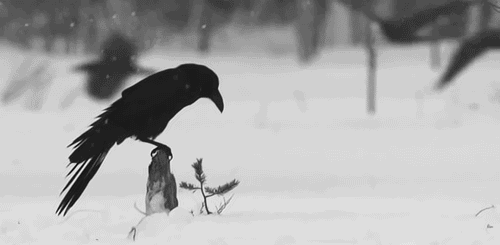
Resources
https://oreamnosoddities.com/blogs/news/how-to-make-a-bindrune-Bindrune explaining
https://oreamnosoddities.com/blogs/news/rune-meanings-the-elder-futhark-elder futhark source
http://www.shieldmaidenssanctum.com/blog/2019/3/12/the-elder-futhark-runes-and-their-meanings- elder futhark sources
https://youtu.be/nK51UmwJxRU-bindrune source from witches view with a little misinfo on Helm of Awe and Vegvisir
https://youtu.be/wG9d95vJibk-Bindrune source from Jackson Crawford
https://youtube.com/playlist?list=PLATNGYBQ-TjrPCf9YGy0qzqca1ypcGs50-Jackson Crawfords videos on runes through historical source
https://youtu.be/IROvre0w6hc-Vegvisir info
https://youtu.be/kW9KbtjyHN4-intro to runes
https://youtu.be/Gjmxu7z04kk-explaining the connection between the runic writing and languages
“Runes For Beginners” Lisa Chamberlain
“A Little Bit Of Runes” Cassandra Eason
“Nordic Runes” Paul Rhys Mountfort
“The Poetic Edda” Translated by Jackson Crawford
“Tales Of Norse Mythology” Helen A. Guerber
https://drive.google.com/file/d/1F5INHBpAeUZ8Ux632760FbNQ0SUHDUGX/view?usp=drivesdk-Reading Past Runes book
https://drive.google.com/file/d/1p5L1BFpUFRte-BVq7XgBdXLjAqqZKKkI/view?usp=drivesdk-Nine Doors Of Midgard book
https://drive.google.com/file/d/1EGtRedzunDGtUYkAbtdDrOQS0ppBBH9t/view?usp=drivesdk-The Big Book Of Runes book
#witchcraft#witchythings#beginner witch#witch tips#witchblr#norse runes#runes#norse mythology#norse pantheon#norse paganism#norse gods#norse heathen#runic#runic magic#study notes#notes#witch community#nordic#rune magic#rune stone#rune symbols#witchyvibes#studyblr#study blog#paganism#wow#runestones#rambles#spilled ink#photography
19 notes
·
View notes
Text
Now that Loki season two has closed the TVA Handbook on Loki’s story, the question remains as to whether Tom Hiddleston has bid adieu to the MCU. It’s hard to imagine a better ending for the former God of Mischief, and since Loki‘s potential series finale aired last week, Hiddleston even referred to the episode as the “conclusion” of his 14-year journey with Loki. However, when pressed further on the subject this week, he then created a little bit of wiggle room for himself to return someday.
For Loki executive producer Kevin R. Wright, Hiddleston’s finale performance felt like a goodbye of sorts.
“I think his approach to that performance certainly was [a send-off], and I think we all felt that on set,” Wright tells The Hollywood Reporter.
But similar to his lead actor, Wright is quick to issue his own caveats.
“We wanted this to feel like a proper ending for our show, but that does not mean that there won’t be more Loki or stories within this world,” Wright adds. “We just wanted to give this a proper ending in a way that we often don’t get to do in the MCU.”
Wright, who originated much of the series’ foundational elements through his own pitch years ago, says that he’s still making the case for more TVA stories in the MCU.
“I would love to keep telling TVA stories. Internally, people pitch everything, and I’m actively like, ‘I want to do more TVA!’” Wright shares. “It will just end up being about where it makes sense for them to come in, in the future, but we all look at that corner of the MCU and go, ‘God, we’re just scratching the surface.’”
Below, during a recent spoiler conversation with THR, Wright also addresses a couple Mobius fan theories and how he’s looking forward to developing future TV series in a more traditional fashion.
So, in the end, instead of killing Sylvie to save time itself, Loki makes the ultimate sacrifice for the good of everyone else, and in doing so, he tasks himself with literally holding the fabric of existence together. And to me, that’s both a tragic and triumphant end. Why was this the right note to end the series on?
I’m glad those are the two feelings, because that’s what we were going for. (Laughs.) I don’t know if I can answer that beyond what you just said; it’s just the right ending to the story. We always knew the show was going to end with Loki on a throne, even in season one, and it was never about where he was going. It was always about the feeling we wanted audiences to feel when he got there, and it was about building the story that led to that feeling. Ultimately, because I don’t want to get too into the weeds on the last ten minutes of the show, we all feel like the answers and the intentions are there on screen.
But what I can say, generally, is that we are all really bored by the binary of hero-villain, good guy-bad guy, good choice-bad choice. In the real world, choices are really complicated. Real heroism often goes completely unrewarded. It often involves people who are making really tough decisions and will never benefit from the sacrifices that they’re having to make. And if you can build a superhero comic-book story that dives into the weeds of a more complicated heroism, then that was a challenge that was worth it to us to try. And Loki is the best character to do that with in many ways.
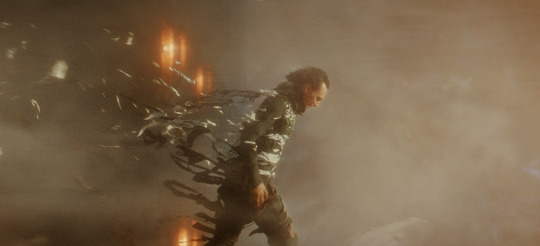
Technically, did Loki become the God of Stories, or a personified version of Yggdrasil, the Norse Tree of Life?
Are those mutually exclusive? It all comes back to questions of free will. Is he writing stories, or is he allowing stories to continue to be told? Is he weaving them together? It’s an interpretation of what exactly he did there at the end, but I think both can potentially be true.
Of course, anything is possible within the comic book genre, but this finale feels like a send-off for Tom Hiddleston as this character. Do you think we’ve seen the last of Tom’s Loki for at least a long while?
I think his approach to that performance certainly was [a send-off], and I think we all felt that on set. We wanted this to feel like a proper ending for our show, but that does not mean that there won’t be more Loki or stories within this world. We just wanted to give this a proper ending in a way that we often don’t get to do in the MCU. But also, in Marvel comics and the history of comics, the end of a comic run doesn’t mean the end of that character or those stories. And if there’s another story to be told or further stories to be told with what we’re doing here — and it’s with the right filmmakers and the right writers and the right team — then we would love to continue to see Tom. I also said this in season one, but I honestly think Tom will play Loki until he’s Richard E. Grant’s Classic Loki. It’s about the right thing and when we’re doing it, and being really careful about how we build those stories.
The TVA still has some unfinished business, as they have to track Kang variants. So will the TVA appear in the MCU again at some point?
I would love to keep telling TVA stories. Internally, people pitch everything, and I’m actively like, “I want to do more TVA!” It will just end up being about where it makes sense for them to come in, in the future, but we all look at that corner of the MCU and go, “God, we’re just scratching the surface.”
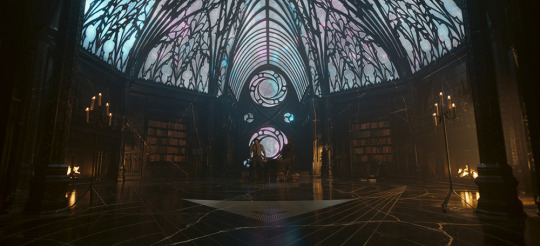
360 sets. You begged and pleaded for them, and they were worth their weight in gold. Kasra Farahani also sounded optimistic that this approach might become more common on other MCU projects. So do you think you’ve successfully made your case to the crested blazers of the Marvel Studios Parliament?
We’ll see. It comes down to the speed at which we make streaming shows, and that’s natural for TV. That’s not a Marvel speed. You’re shooting a lot in small schedules, and it’s benefited by having sets and not having to do a ton of VFX in every shot. It makes good practical sense, and there’s a reason why people did it for a hundred years of moviemaking. It’s about when it makes sense for our stories, certainly, but we’re also telling comic book stories, and sometimes, things have to be more fantastical than what you can build. So it’s about being smart and how you do it. I love it, and I know our team loves it. When we were shooting Loki, we had a number of filmmakers who visited set, and their reactions were like, “They let you build all this?” And it’s like, “Yeah! Wait, you’re not? You should be doing this, too.” (Laughs.) So, long answer short, yeah, I think people have seen what we did and they see that it’s an option now, and will hopefully embrace it.
Fan theories can be both a blessing and a curse, as your friends on WandaVision know, but have you lost any sleep over not making the McDonald’s kid a young Mobius (Owen Wilson)?
No, but I love that theory. I also saw that maybe Mobius is an Odin variant, and that was really imaginative and cool, too. So it was never discussed and I never lost sleep over it, although I read all that stuff and I love it. Partially why Loki feels more densely layered than some other projects is we know that people are looking at it in that way and are digging into everything. So everybody on the team really embraces that and goes, “If it’s in frame, it has to hold up the scrutiny.” We’re either subliminally hiding things in there, or we’re putting things in there to misdirect so that we can better impact people with something more surprising. But I love that people engage with it that way, and I hope that they see that we are engaging back with them in how we build the show.
And what about a medium shot of Loki and Mobius on the tandem bicycle? Do you regret that you won’t see that meme for the rest of your life?
No, because I can go online and I can see it in all of the amazing fan art. It’s out there. We knew you just had to handle that with a very light touch, and the audience will fill in the blanks. And they beautifully have.
Marvel made a bunch of release date moves recently, and we’re not going to see much of you in 2024. Are you a bit relieved since Marvel Studios’ own temporal loom won’t be overloaded?
What’s exciting to me — and this is something [head of streaming at Marvel] Brad Winderbaum has talked about — is what I personally will get to be making next. We’ll really be able to have the time to slowly build it, find the right team for it, find the right people to develop it, build a pilot and build things on a more traditional schedule. It’s a little bit like the sets. It’s good, it’s practical, it’s smart, and when things are done right with the right team, these projects can be really, really good. And I think Loki is really, really good. So, if we give the development and production cycle the right amount of attention and build a calendar in a way that allows us to really do this correctly, you will get to see more projects that are of this caliber. It’s just about giving the creatives the space and the resources to do things properly. So, ultimately, this is a really good thing. I know people want more, but I also know that if we take time with it, they will appreciate what they get.
Well, the ultimate compliment I can pay all of you is that I didn’t care much for Loki prior to this series, and not because he was a bad guy or anything like that. This show fulfilled the original promise of these Marvel Disney+ series by deepening this character in a way that the movies don’t have time for, and I have nothing but fondness for Loki now. So Loki should be the case study for how valuable Disney+ can be for Marvel.
One, thank you. Two, I agree. I know that our writers, Justin [Benson], Aaron [Moorhead], Kate [Herron] and everybody would also agree, and that was the most appealing part of this. You can slowly take your time and build a really fulfilling story. We have very little action this season. (Laughs.) There’s a lot of thrills and there’s a lot of big stuff, but it was about really taking our time to build a character story that can feel truly fulfilling. So I look forward to being able to do more stories this way.
28 notes
·
View notes
Text
Norn - Day 70
Race: Megami
Alignment: Light-Law
Arcana: Fortune
July 12th, 2024

Fate is a fickle thing. Concepts of fate have existed throughout many world religions, mythologies, and superstitions- walk under a ladder, and fate may bring you ill fortune, after all- or perhaps, a black cat will bring bad luck. Most mythologies have specific deities or beings dedicated to fate, or one's own life- take, for example, the Greek Moirai sisters, or today's Demon of the Day, a Nordic subset of deities who spin the wheel of fate and measure one's own time left to live, the Norns, A set of three Jötunn who paint pictures of one's fate and judge them to see how their life shall go.
Depicted in the Völuspá, the most famous poem in the Poetic Edda, the sisters Norn are depicted as caretakers of the great tree Yggdrasil, as said in the passage below. The Poetic Edda is, of course, an intense and long story, and while the Norns aren't given many mentions, their role is still as important as any other deity- that being to take care of the tree of life, keep it alive, and keep humanity and the Æsir alive in tow. As described as well, the poem also goes over their role in fate. To quote,
I know an ash tree, named Yggdrasil:
Sparkling showers are shed on its leaves
That drip dew, into the dales below,
By Urd's well it waves evergreen,
Stands over that still pool,
Near it a bower whence now there come
The Fate Maidens, first Urd,
Skuld second, scorer of runes,
Then Verdandi, third of the Norns:
The laws that determine the lives of men
They fixed forever and their fate sealed.
The well they drew this water from, Urðarbrunnr, named so after one of the Norns themselves, contained sacred water that could wash away the rot gnawing at the tree's roots, nourishing the grand tree and keeping it from bringing about the death of the realms riding upon it. Beyond just this, though, what's the deal with the fate imagery? Well, it's complicated. The three Norns are, in effect, the 'Primary' Norns- there were attestations by Snorri Sturluson, the primary compiler of the Poetic Edda, that there were far more that watched over the fates of man themselves. As stated by pre-Christian Scandinavian sources, and later recalled by Snorri in the Prose Edda's first book, there were good and evil Norns. To quote,
"If the Norns determine the weirds of men, then they apportion exceeding unevenly, seeing that some have a pleasant and luxurious life, but others have little worldly goods or fame; some have long life, others short." Hárr said: "Good norns and of honorable race appoint good life; but those men that suffer evil fortunes are governed by evil norns."
As implied, it's said that Norns were different from just being three fates- they were, in effect, guardian angels, those who watched over others and ensured their fates. I personally find it interesting that this is one of the only major differences between the Norns and the Sisters Moirai, as the three main Norns do not govern the fate of everyone; everyone instead has their own Norn to govern them and their time. The main three, Urd, Skuld, and Verdandi, seem to simply be major Norn figures who protected the fate of all of life itself through their attending of Yggdrasil.
Looking at the design of the Norn in SMT, I believe it's less meant to represent the three sisters, and more of the overall concept of them as guardians who represent fate. The three Norn surrounding the clock do appear to be allusions to Urd, Skuld, and Verdandi, but the clock itself seems to be drawing comparison to the concept of fate- the idea that, when the clock ends, the one they watch over shall die.
To completely swerve topics, @averagefungus was the one who got the easter egg in the Alice DDS first! Congratulations! To answer what it was, if you look at the first letter of each paragraph, it spells out DIE FOR ME!
8 notes
·
View notes
Text

Yggdrasil: The Sacred World Tree
Talon Abraxas
Yggdrasil: Unveiling Mysteries of The Sacred World Tree
Yggdrasil, also known as the Tree of Life, stands at the center of the Norse cosmos, serving as a conduit between the nine realms. Its immense branches extend across the heavens, and its roots delve deep into the great realms, tapping into legendary wells and streams for sustenance. This colossal ash tree serves as a cosmic axis, linking together the realms of gods, humans, giants, and various other beings.
Roots of Yggdrasil
Yggdrasil's roots draw power and sustenance from three different sources. The first root reaches up towards heavens and into Asgard, the realm of the gods, and taps into the well of Urd. Shielded by the root’s magic, by the well stands a beautiful hall that is home to three maidens – Urd, Verdandi, and Skuld – who shape the lives of men and are known as norns.
The second root extends to Jotunheim, the domain of the giants. Here, the root taps into the Mimir’s well, whose waters are coveted by many for containing boundless wisdom and which is guarded by its eternal guardian Mimir. Here, at Mimir’s well, Odin sacrificed his eye for a drink from the well to obtain supreme wisdom and solidify himself as the leader of the Aesir.
The third and final root travels to Niflheim, the icy realm of the dead. This root taps into the wellspring of Hvergelmir, a massive cauldron from which all rivers originate, symbolizing the primordial source of life and creation. This wellspring is a home to many snakes and serpents, with the great dragon Nidhoggr living among them.
Within the vast expanse of Yggdrasil, there exist nine interconnected realms. In addition to Asgard, Midgard, and Niflheim, the World Tree also links to realms such as Vanaheim (abode of the Vanir gods), Alfheim (dwelling of the light elves), Jotunheim (the land of giants), Svartalfheim (the domain of the dwarves), Muspelheim (the realm of fire) and Helheim (abode of the dead). Each realm has its own unique characteristics, inhabitants, and significance within Norse mythology.
Among the Branches of Yggdrasil
Asgard: Home of the Aesir Gods
Asgard, situated atop Yggdrasil's highest branches, is the realm inhabited by the Aesir gods. Ruled by the mighty Odin, Asgard is a place of divine splendor, where grand halls and palaces stand in golden brilliance. It is from Asgard that the gods oversee the mortal realm, engage in epic battles, and prepare for the final battle of Ragnarok.
Midgard: The Realm of Humans
Midgard, often referred to as Earth, is the realm of humankind. Suspended within Yggdrasil's middle branches, it is a world populated by mortals, their settlements, and their adventures. Midgard is constantly influenced by the gods and their actions, shaping the fate of both individuals and civilizations.
Jotunheim: The Land of Giants
Jotunheim, nestled within the roots of Yggdrasil, is a realm inhabited by the jotnar, or giants. These formidable beings range from mountainous brutes to cunning and deceptive creatures. Jotunheim serves as a land of challenges and conflicts, frequently intersecting with the affairs of gods and heroes.
Vanaheim: Abode of the Vanir Gods
Vanaheim is the realm of the Vanir gods, a pantheon associated with fertility, prosperity, and nature. Located within Yggdrasil's branches, Vanaheim is depicted as a lush and fertile land, where bountiful harvests and vibrant ecosystems flourish under the Vanir's watchful eye.
Alfheim: Dwelling of the Light Elves
Alfheim, situated above Midgard, is a realm inhabited by the ethereal and luminous light elves. Known for their beauty and connection to nature, the light elves possess great wisdom and magical abilities. Alfheim is often associated with light, joy, and enchantment.
Svartalfheim: Domain of the Dwarves
Svartalfheim, residing within the depths of Yggdrasil, is the realm of the industrious and skilled dwarves. Known for their craftsmanship and mining expertise, the dwarves forge powerful weapons, legendary artifacts, and intricate treasures. Svartalfheim is a realm of hidden caverns and wondrous craftsmanship.
Niflheim: The Frozen Underworld
Niflheim lies beneath the lowest roots of Yggdrasil, a cold and mist-shrouded realm associated with ice, frost, and darkness. It is home to Hel, the ruler of the dead, and the souls of evil men who passed into this ice realm after traversing Helheim.
Muspelheim: Realm of Fire
Opposite Niflheim, Muspelheim exists as a realm of searing flames and intense heat. Ruled by the fire giant Surtr, Muspelheim embodies the primal power of fire and is foretold to be instrumental in the apocalyptic event of Ragnarok.
Helheim: Abode of the Dead
Helheim is a realm of the dead, located beneath the roots of Yggdrasil. It is a somber and desolate place ruled by the goddess Hel, where souls who did not attain glory in battle or gain entrance to other afterlife realms reside. It represents the acceptance of mortality and the finality of death in Norse mythology.
Inhabitants of Yggdrasil
Yggdrasil is not only a physical entity but is also inhabited by various mythical creatures. Beneath its roots resides Nidhoggr, a colossal dragon who gnaws at the roots of the tree, representing decay and destruction. The eagle perched on Yggdrasil's highest branches looks down on Nidhoggr below, embodying knowledge and inaction. The squirrel Ratatoskr scurries up and down the tree, acting like a messenger between Nidhoggr and the unnamed eagle, fanning the flames of hate between them by spreading nasty rumors and ferrying insults that one has for another. These inhabitants further contribute to the vivid and complex tapestry of Norse mythology.
Symbolism of the World Tree
Yggdrasil is a profound symbol in Norse mythology, representing the interconnectedness of all things in the cosmos. It embodies the cyclical nature of life, death, and rebirth, underscoring the idea of continuous renewal and regeneration. As a world tree, it also symbolizes the axis mundi, a universal concept found in many mythologies, where the physical and spiritual realms meet.
The image of the tree resonates deeply with human existence, reflecting the innate human desire to seek meaning and connectivity. It reminds us of the intricate web of relationships that bind us to the natural world and the forces beyond our comprehension.
Yggdrasil, the World Tree of Norse mythology, is a powerful symbol that encapsulates the cosmos and its profound interconnections. It serves as a gateway to the realms of gods, giants, and the dead, and its roots tap into the wellsprings of cosmic wisdom and primal creation. As we delve into the mysteries of Norse mythology, we unravel the layers of symbolism embedded in this awe-inspiring ancient tree, reminding us of our place in the grand tapestry of existence.
So, let us gaze upon Yggdrasil, this towering arboreal monument that stands as a testament to the enduring power and enduring fascination of Norse mythology. May its endless branches forever inspire us to explore the depths of our own roots and seek wisdom in sacrifice.
40 notes
·
View notes
Text
Connections between Gods of Stories: Breaking the Cycle and Rewriting Reality
From "Loki God of Stories - A Comparison between MCU and Comics" series - Co-Written by @lucianalight (Luci) and @theitcharchives (Hollow)
Ouroboros, the snake that devours its own tail, is an ancient symbol of birth and rebirth in a never ending cycle for eternity. It appears in many mythologies around the world including Norse mythology, with the serpent Jörmungandr encircling the world with its tail in its mouth.
Like an ouroboros, Loki is trapped repeating certain moments again and again, but no matter what he tries, the outcome doesn’t change. In the comics, it’s him trying to escape the role of villain and Ragnarok. In the series, it’s him trying to find other ways besides killing Sylvie and saving the tyrant who takes away everyone’s free will in exchange for constrained stability, or letting everyone decide and allow the basis for a multiversal war. There is also a nice parallel between comics and MCU here. In comics kid Loki wanted Loki to choose his path aka die as himself. Classic Loki wanted him to choose the old role. And in MCU Loki could either die with the destruction of all universes or kill Sylvie and become a villain. It's a recurring cycle in both mcu and comics. Loki either dies a hero or has some scheme(betrayal, escape, etc).
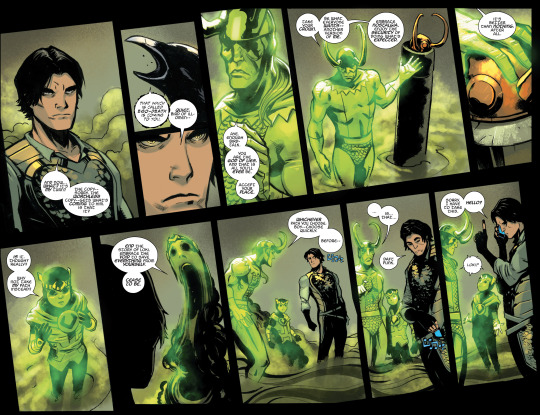

But series Loki doesn’t like either option. So he finds another way, like comics Loki. For the people he loves, for everyone, and for himself. And I (=Luci) can’t help but think that “For you, for all of us” in a way is breaking the fourth wall. Loki’s also saying it to us who love him and followed his story all these years.

“It’s not your story. It never was.” [Renslayer, S1E1]
When Loki asks “how does it all end?”, Mobius answers: “It’s a work in progress...They’re untangling the epilogue from its infinite branches.” Not far from the truth, actually. There was a point after which HWR couldn’t predict anymore what would happen: it was Loki time slipping, again and again, until he made the final decision of replacing the equation. The end wouldn’t be clear before Loki arrives in the TVA and before he starts his Journey from there in season 2. The multiverse fate depended on the decision he would take in the future.
Each time Like time slips, the cycle repeats:
Sylvie kills HWR
The loom overloads and deletes branches except scared timeline which causes HWR's reincarnation(Remember while Loki does remember all his time slippings HWR doesn’t)
in sacred timeline Loki escapes with the Tesseract
TVA gets him until he reaches HWR’s citadel with Sylvie
return to number 1,
until Loki destroys the loom and creates the tree and the loop(1 to 4 repetition) breaks.
So the cycle starts with Loki getting to the TVA until it breaks with Loki always keeping the timelines alive. It is a dynamic similar to what happens in Sandman S1E11, A Dream of a thousand cats. When the cat asks Dream of the Endless if a world dominated by humans and not cats was the actual reality, Dream replied that it had always been so once the humans dreamed of it. So the narrative strand of the cats’ world and of the humans’ world can exist in parallel, as HWR’s reign and Loki’s reign do–there was always a sacred timeline, until Loki replaced it with Yggdrasil that always existed (which is why Doctor Strange was able to see billions of outcomes in IW).
So now, there are two parallel narratives, one where time was always constrained into the sacred timeline which led to the happenings of the season one and two, and one where Loki has always sat in Yggdrasil and held the timelines. The first narrative has always been true, until Loki disrupted it, and now the second narrative has always been true (like the humans dream-changing the world as it has always been).
This needs to be true for both the beginning and the end of the series to exist. So Loki substituting the narrative is him reshaping reality, retelling the story of the universe. Which makes him this universe's God of Stories. Even God of the Story, if we consider his Yggdrasil the creation myth that spawns all others.
There were other examples of the loop too, most notably Ouroboros himself. Was OB inspired by Timely or vice versa? Who came up with that knowledge first? Who was there first? HWR, Timely or OB?(It is my personal idea that this very thing was what actually led to OB being named like that, and the Ouroboros parallels are Luci’s mind connecting dots -Hollow)
This is how comics Loki defeats the gods sitting above in the shadows. Did the gods create humans, or did the humans create their gods? What about gods of gods? Who created who first? It's a never ending loop. A never-ending story. Just like how Loki’s story was cycling in a loop.
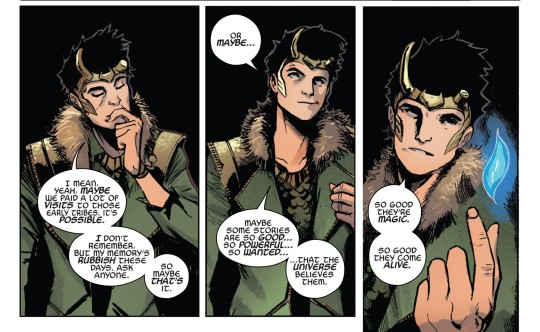

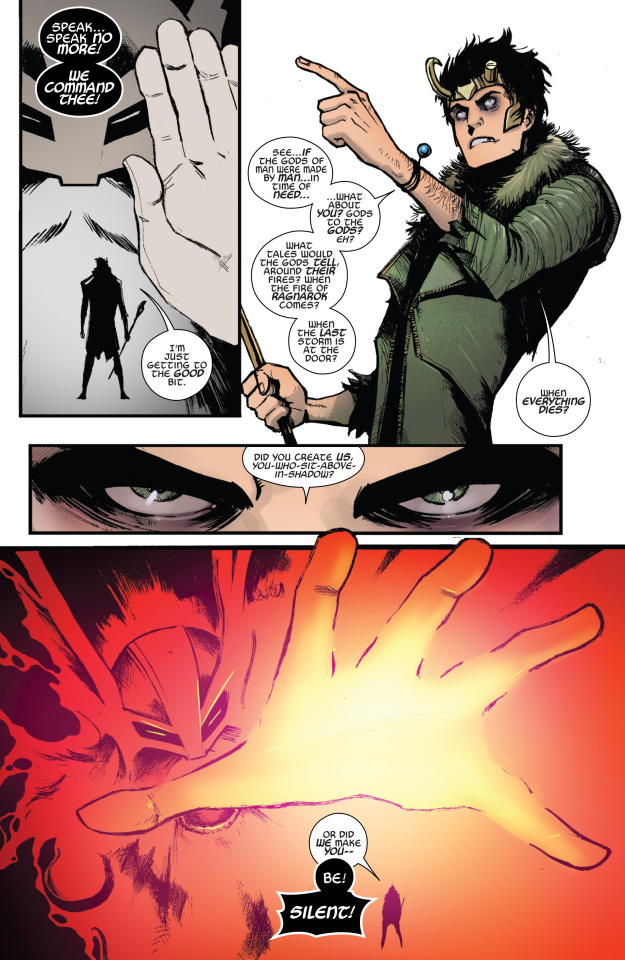
From the ancient Egyptian to now “the loop – so often represented by the ouroboros – has been inextricably bound to our concept of time.”[s]
I (=Luci) have to appreciate how the series keeps the theme and lore through both seasons and connects it to the ouroboros mythology. The sacred timeline is shown as a circle surrounding the HWR’s castle. “The ouroboros in its original Egyptian context symbolizes repetition, renewal, and the eternal cycle of time.”[s] And when HWR is talking about managing the timeline it is shown as a circle around him. Like how “In the more widespread Roman variant of Iranian Mithraism, Zurvan, symbolizing ‘boundless time’, is depicted with an ouroboros entwined around his body.”[s]


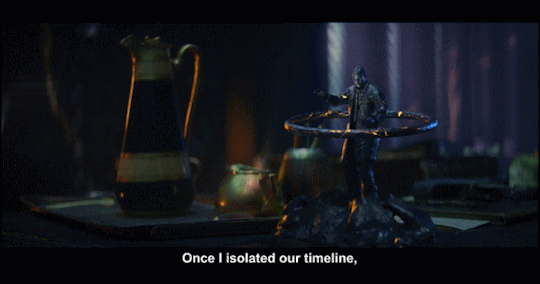
“The Renaissance-era alchemists saw the ouroboros as something to break out of in pursuit of a linear, rather than cyclical, eternity”.[s] When Loki breaks the cycle by becoming the god of stories, the timelines shape Yaggardsil, tree of life. A tree of stories just like how comics showed the stories as a tree.
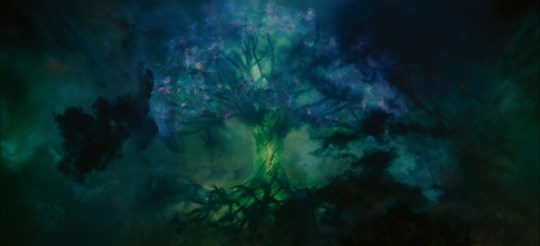
The existence of everyone’s stories depended on him. Loki became the god of stories by giving everyone the chance to write their own stories. The story was always about him. For all time, always.
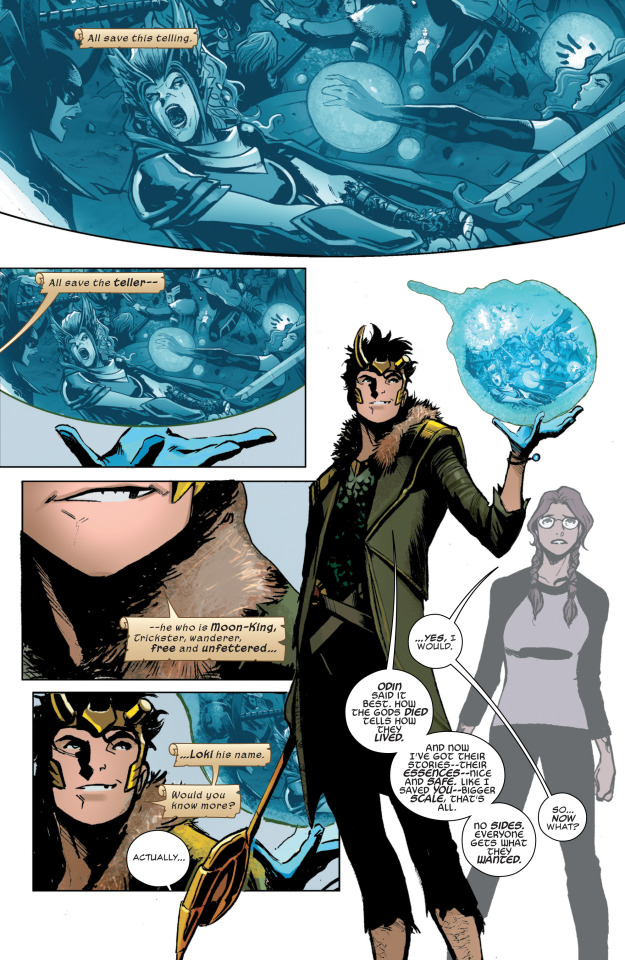

Source: The ancient symbol that spanned millennia
Previous - Next
29 notes
·
View notes